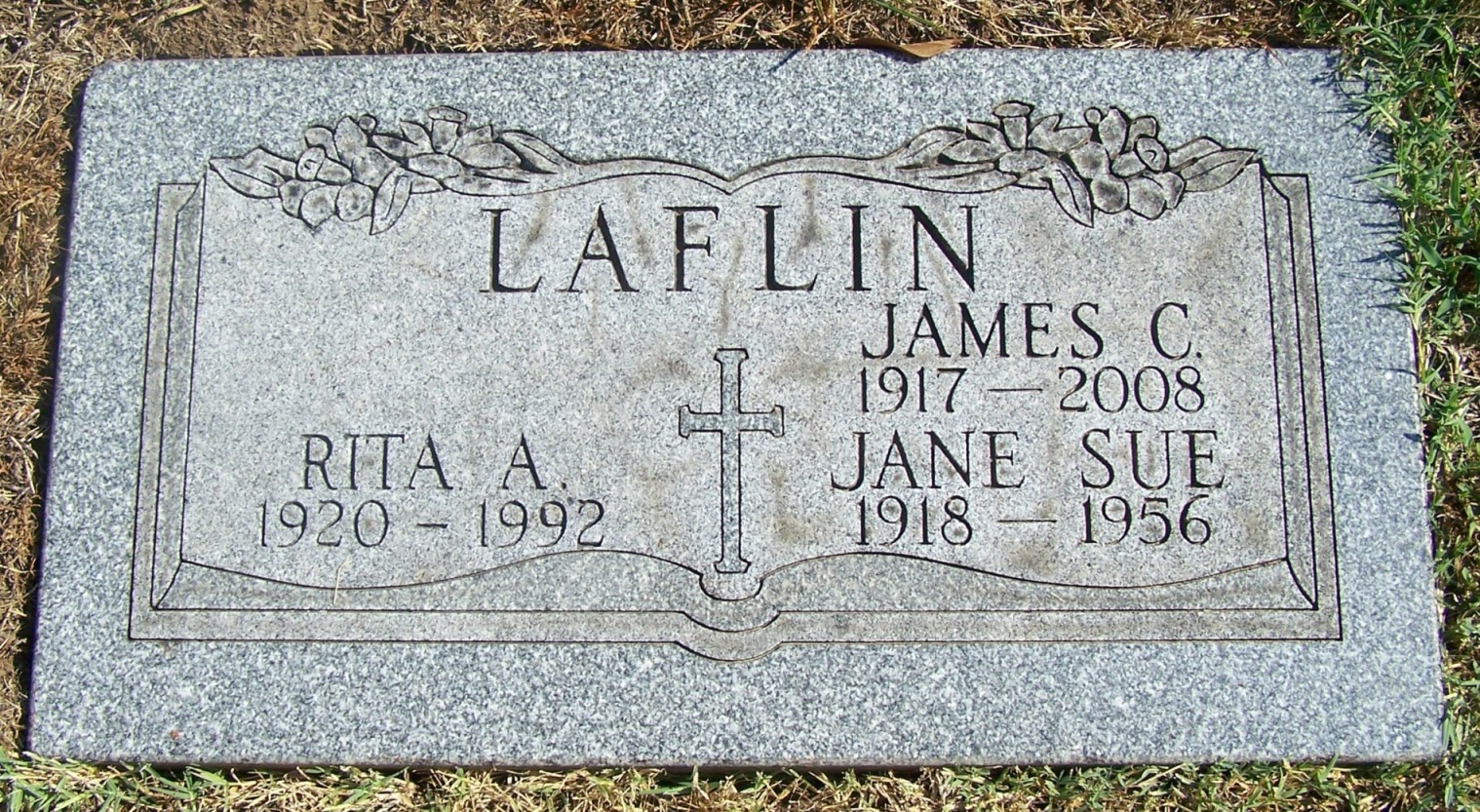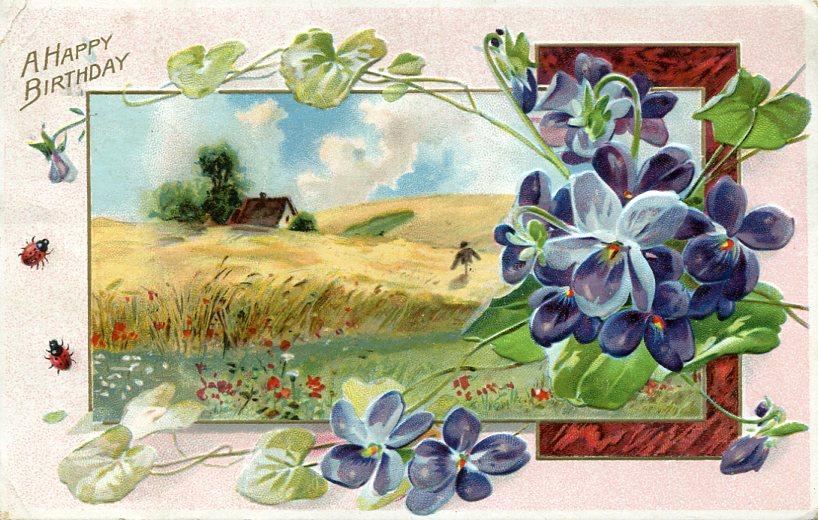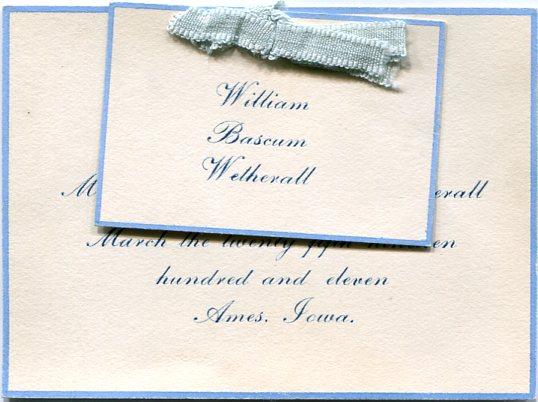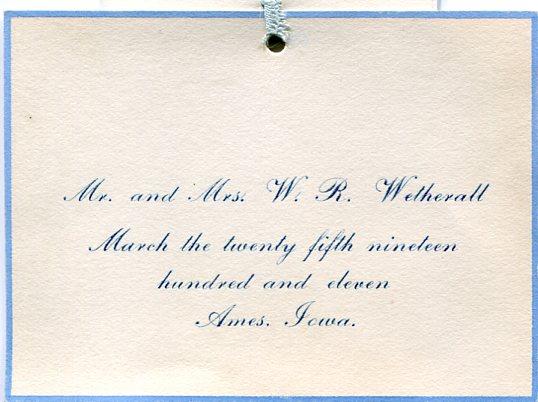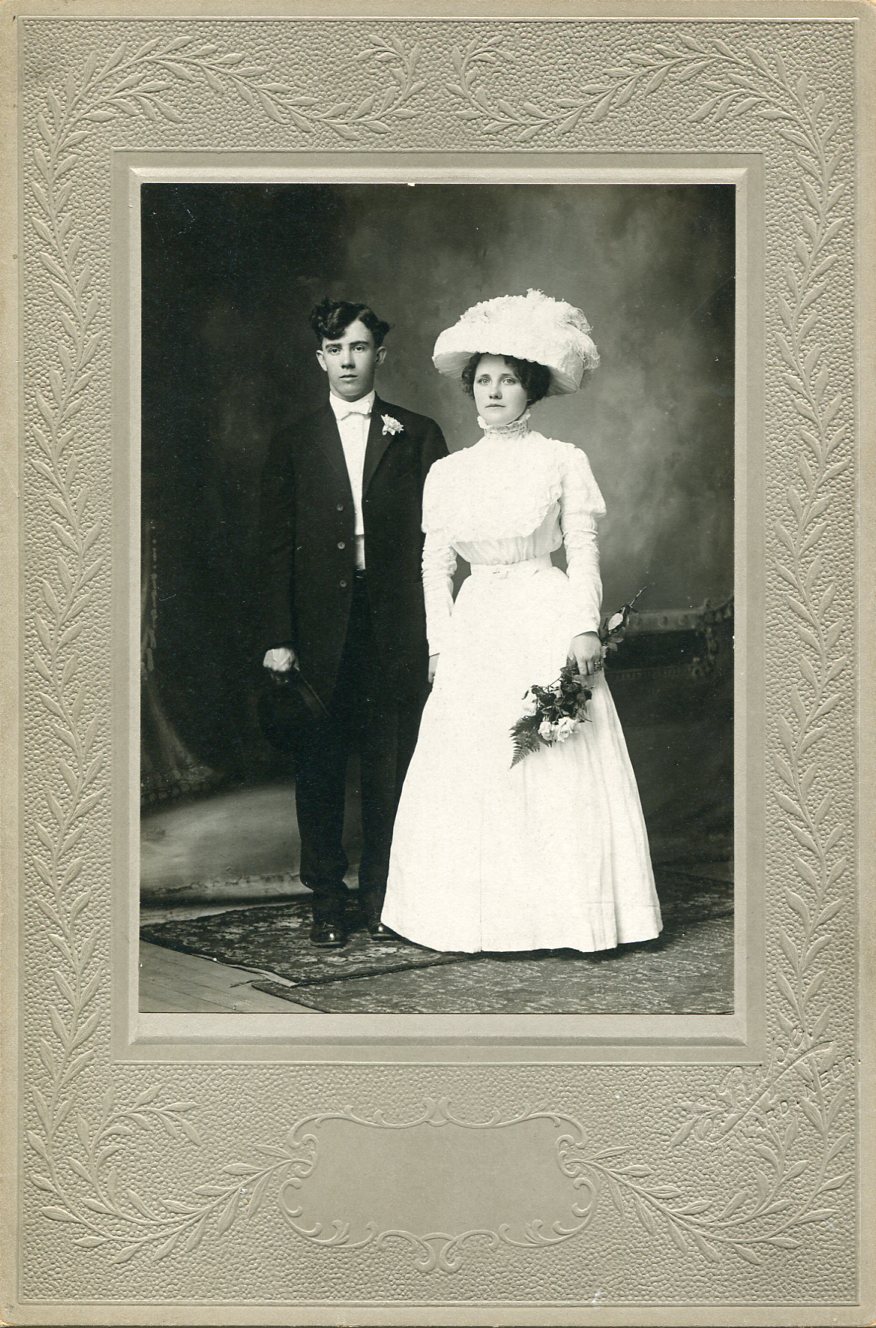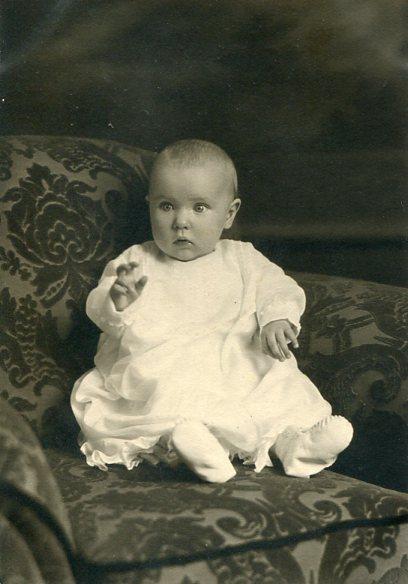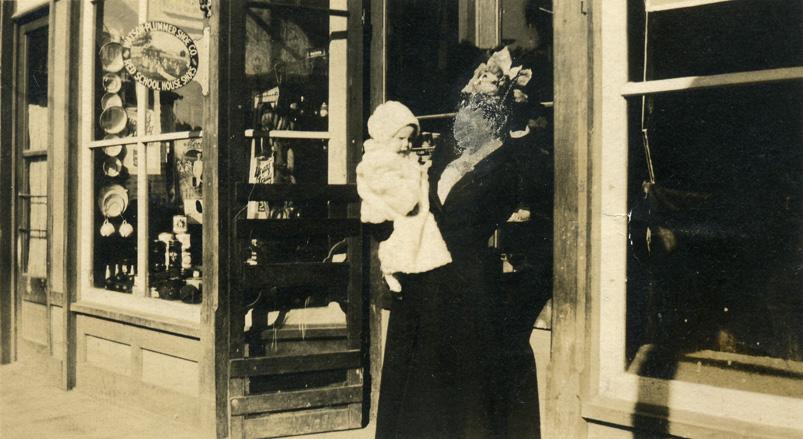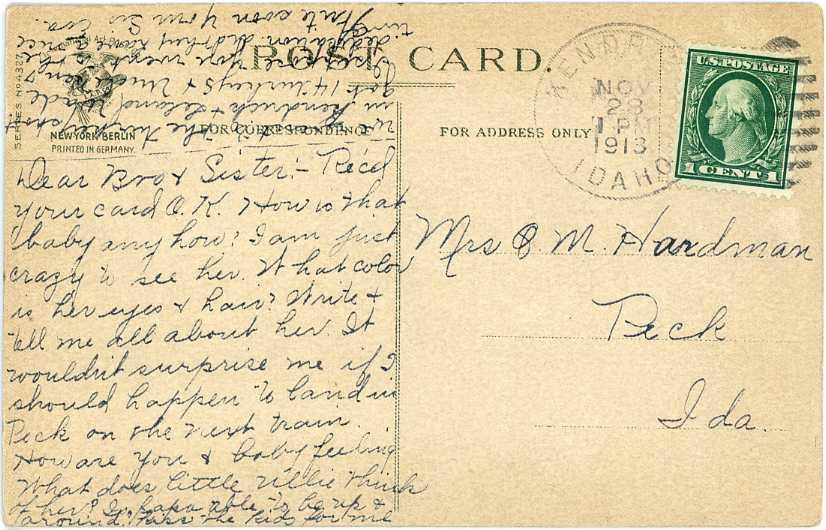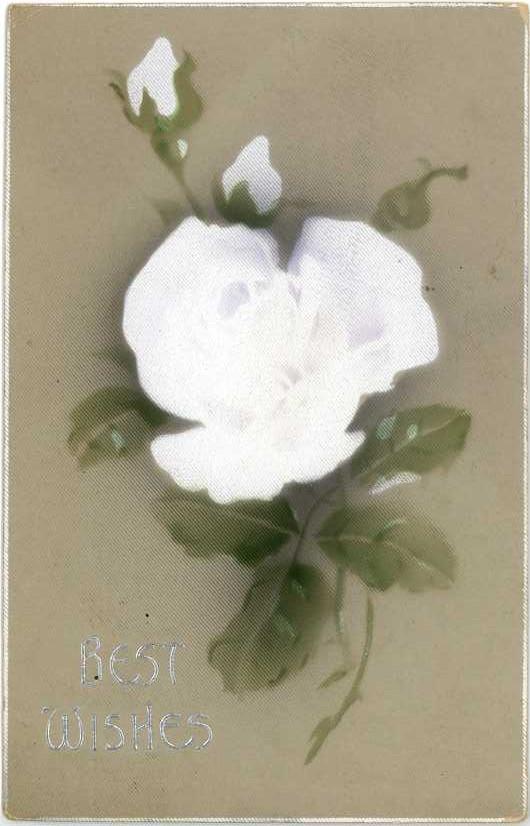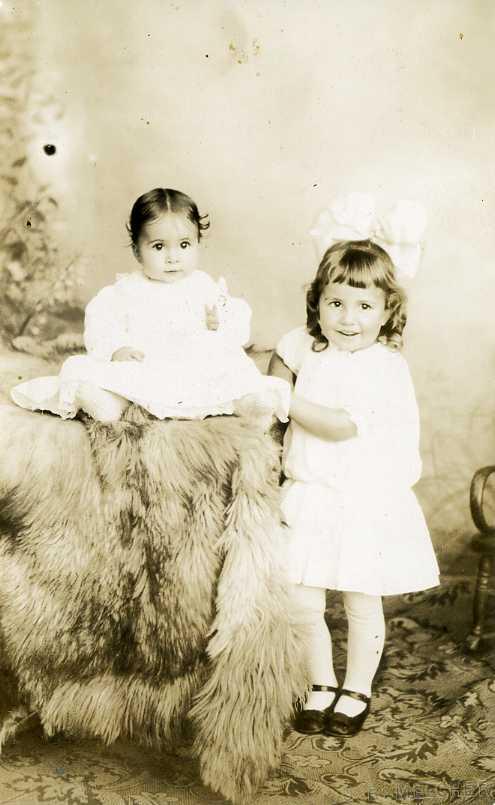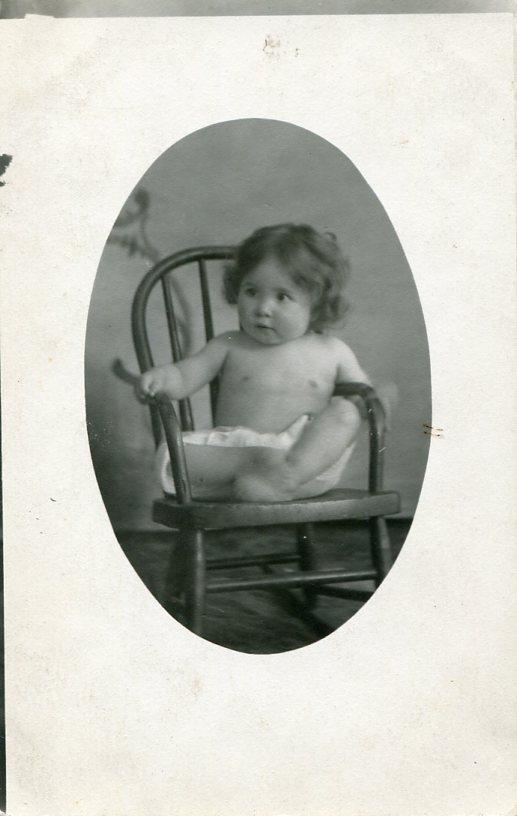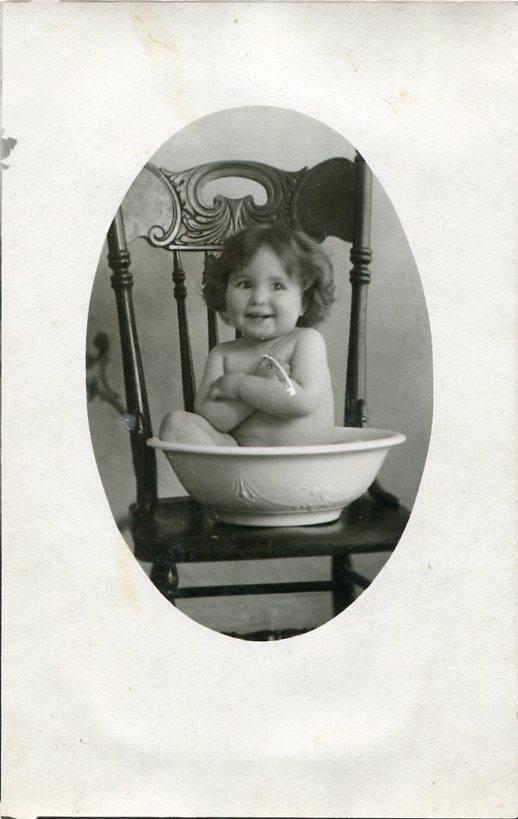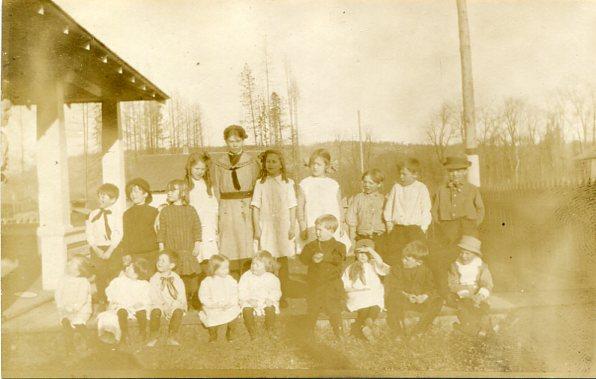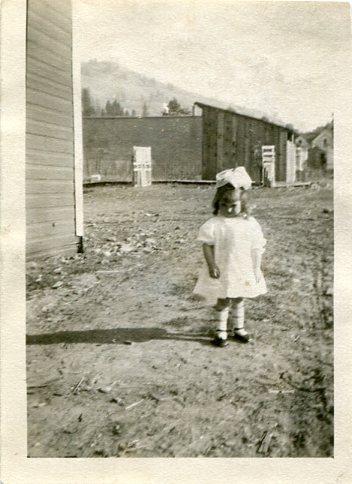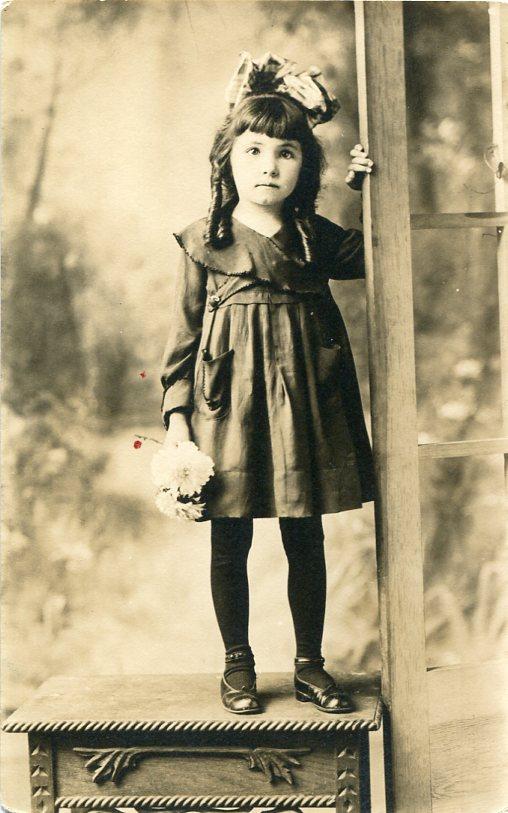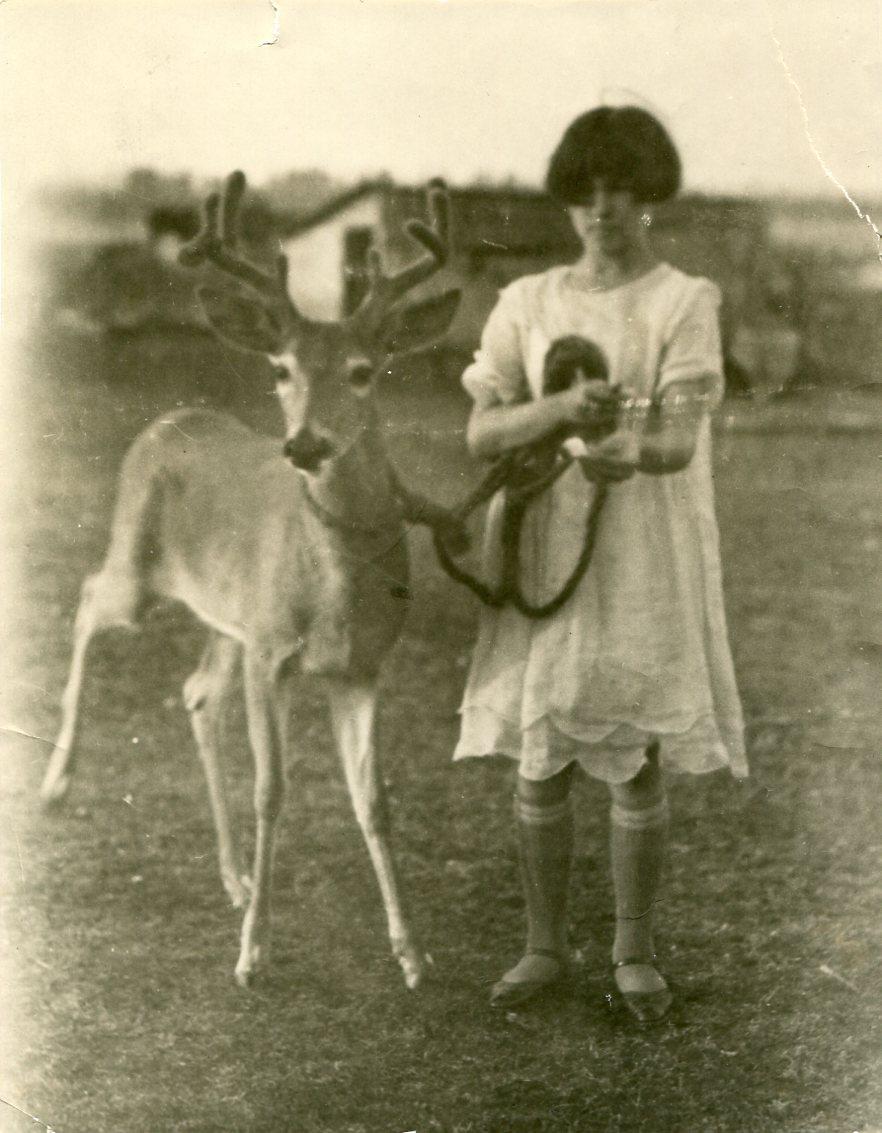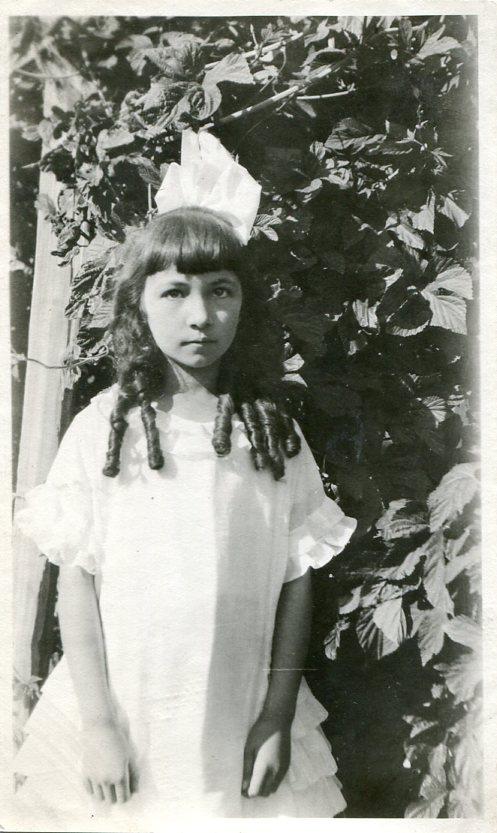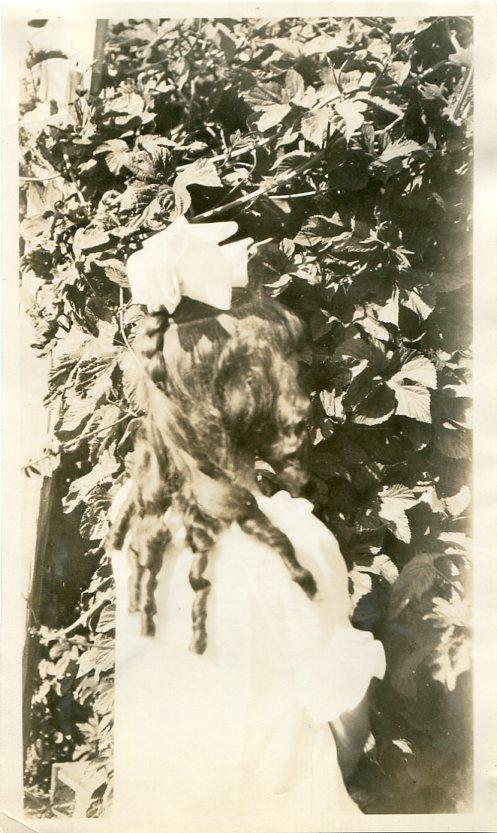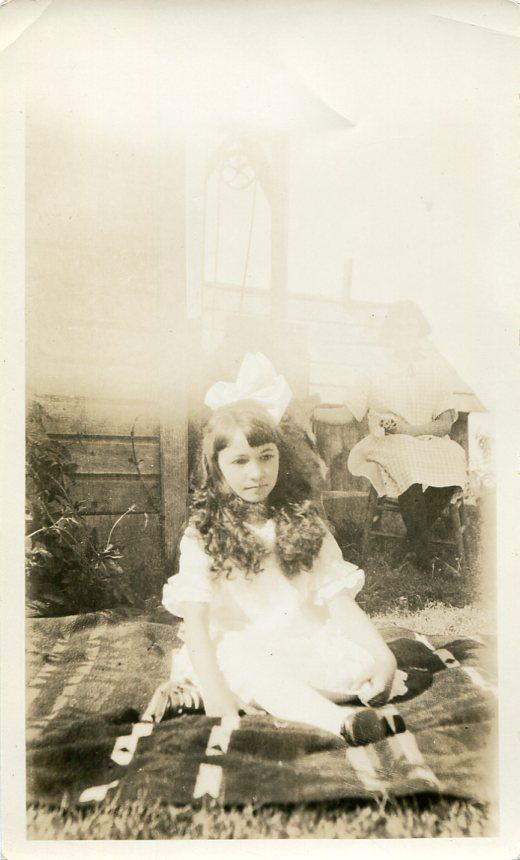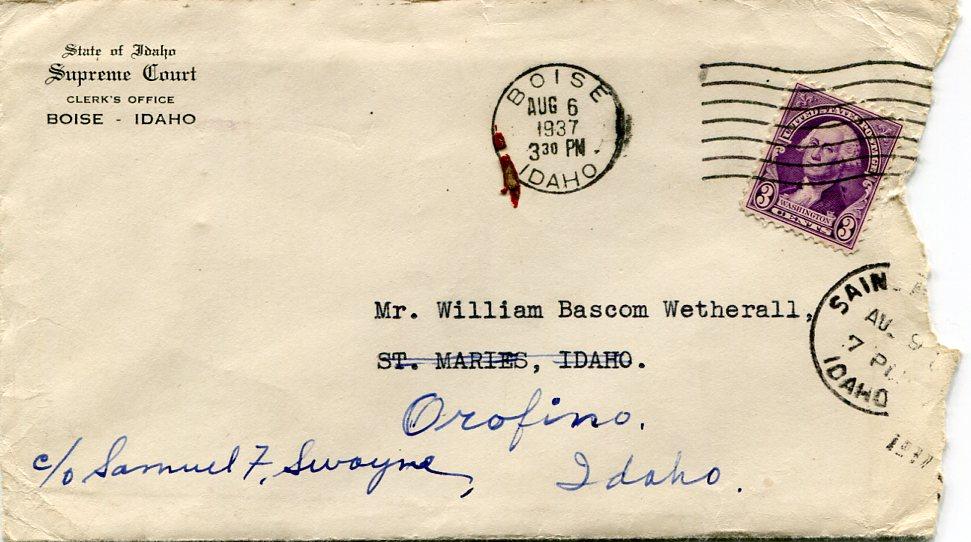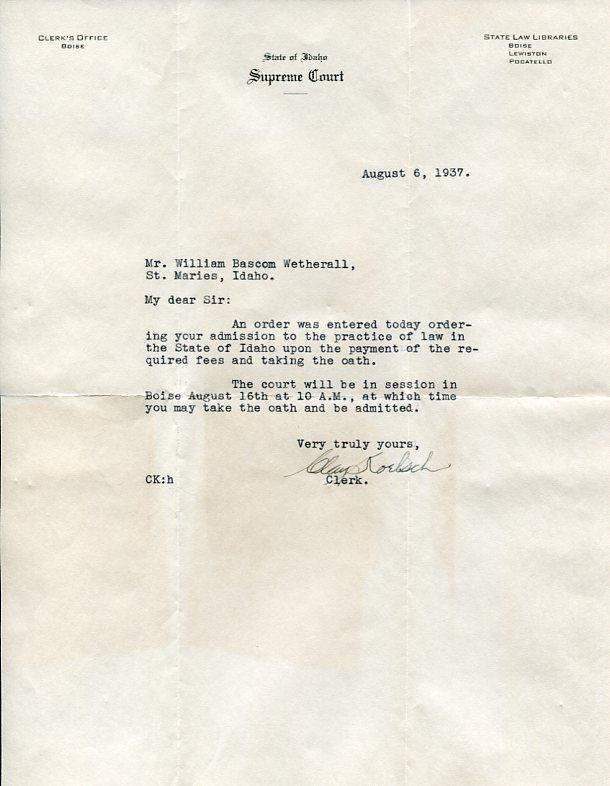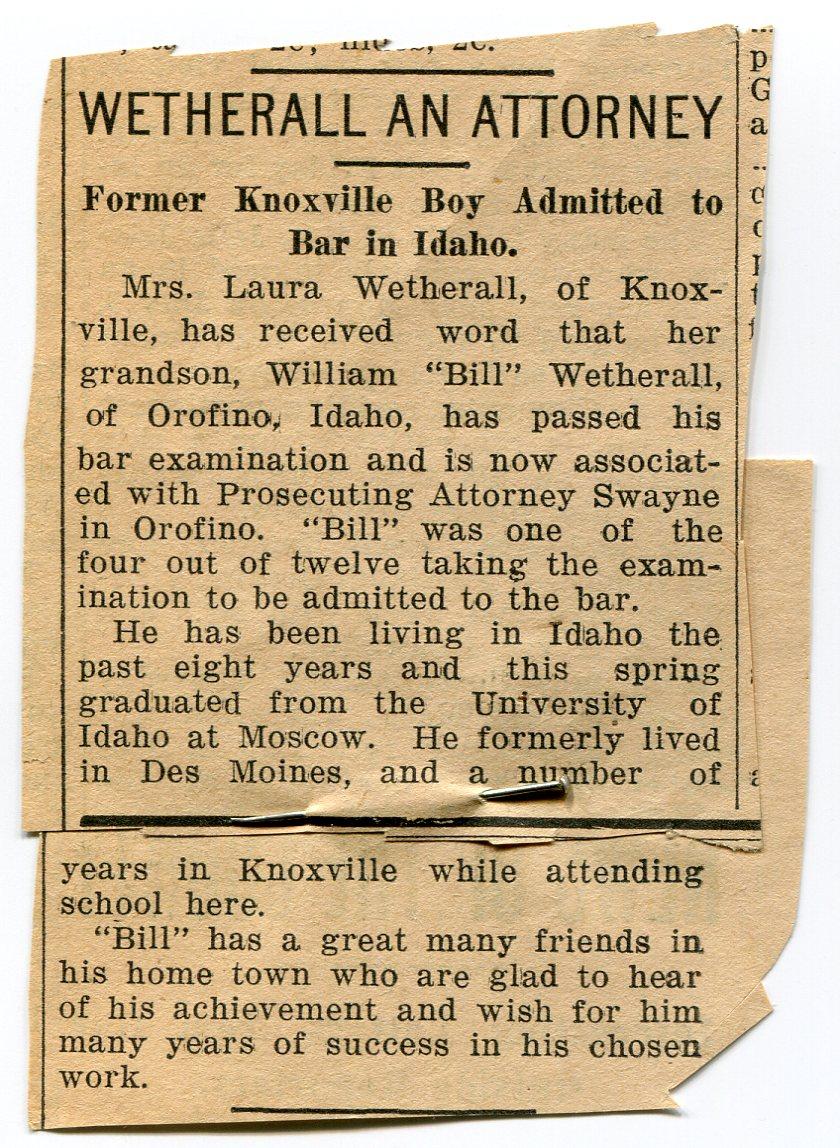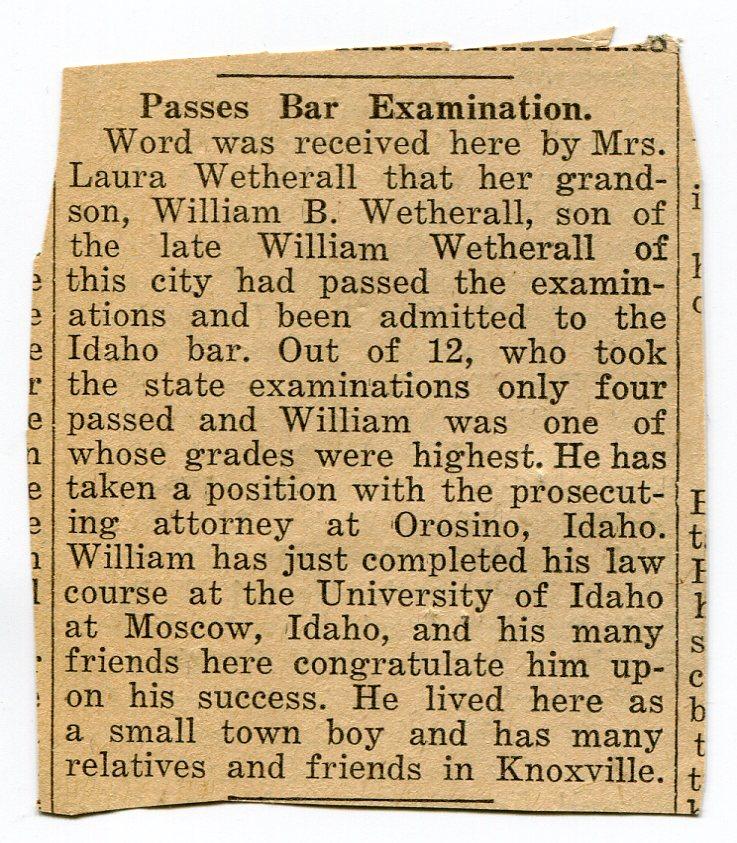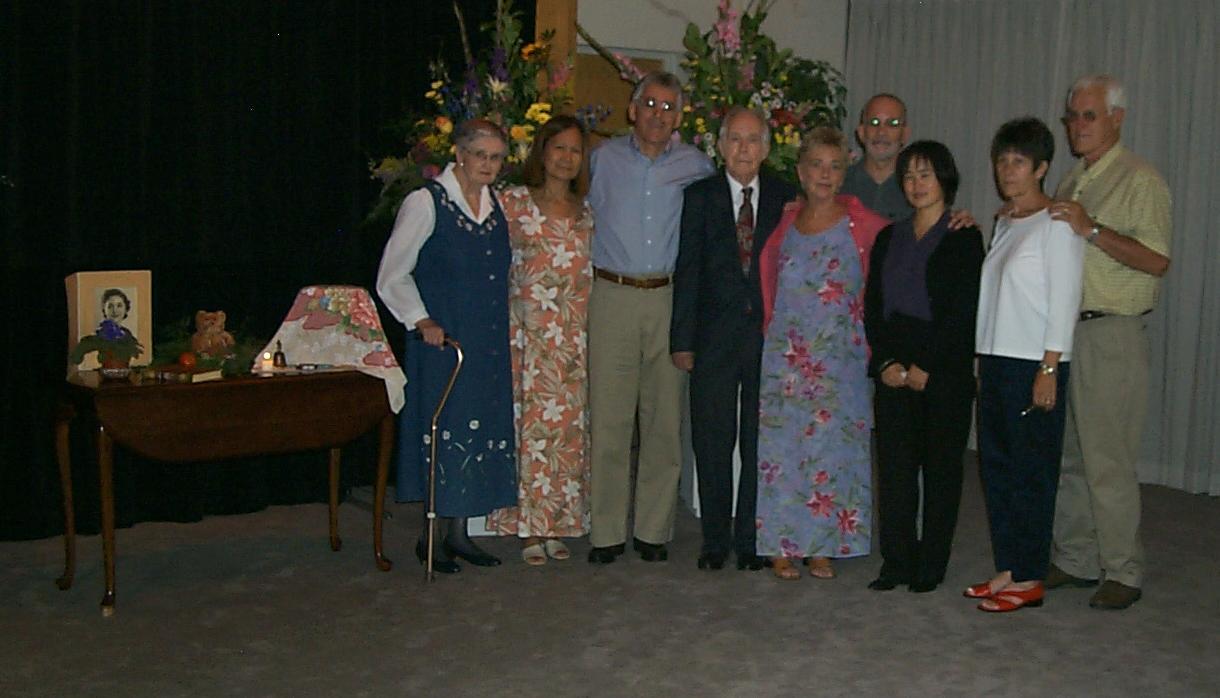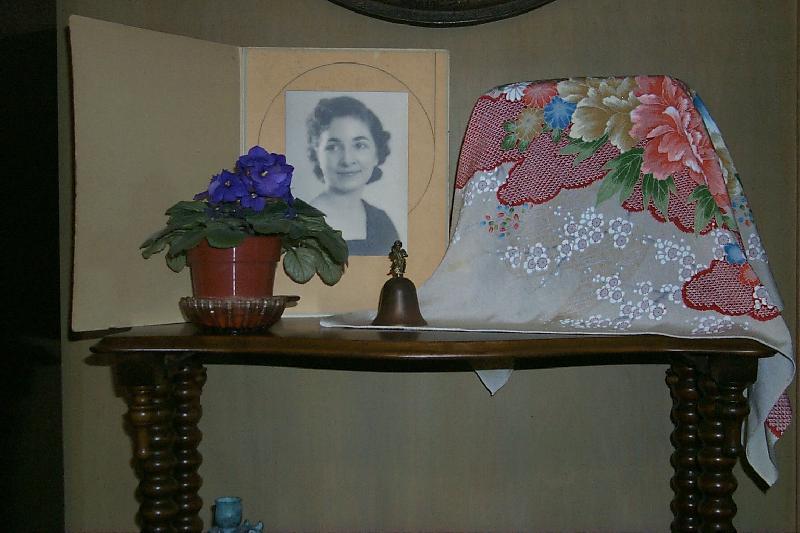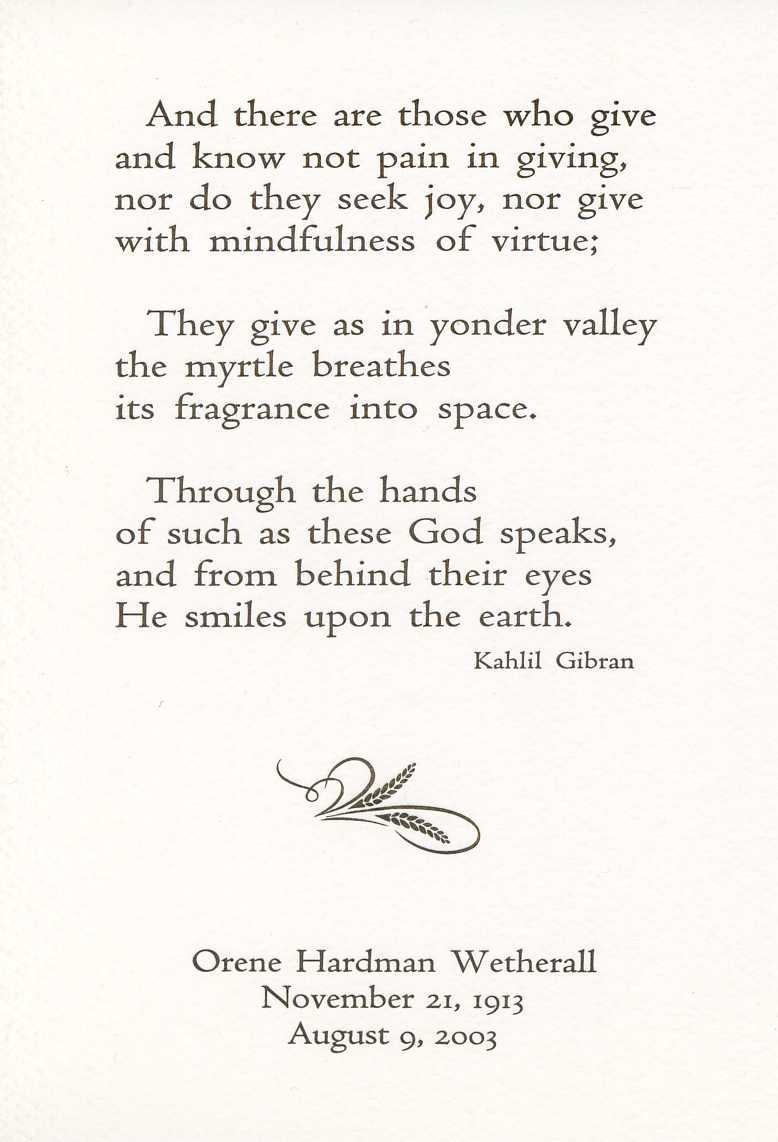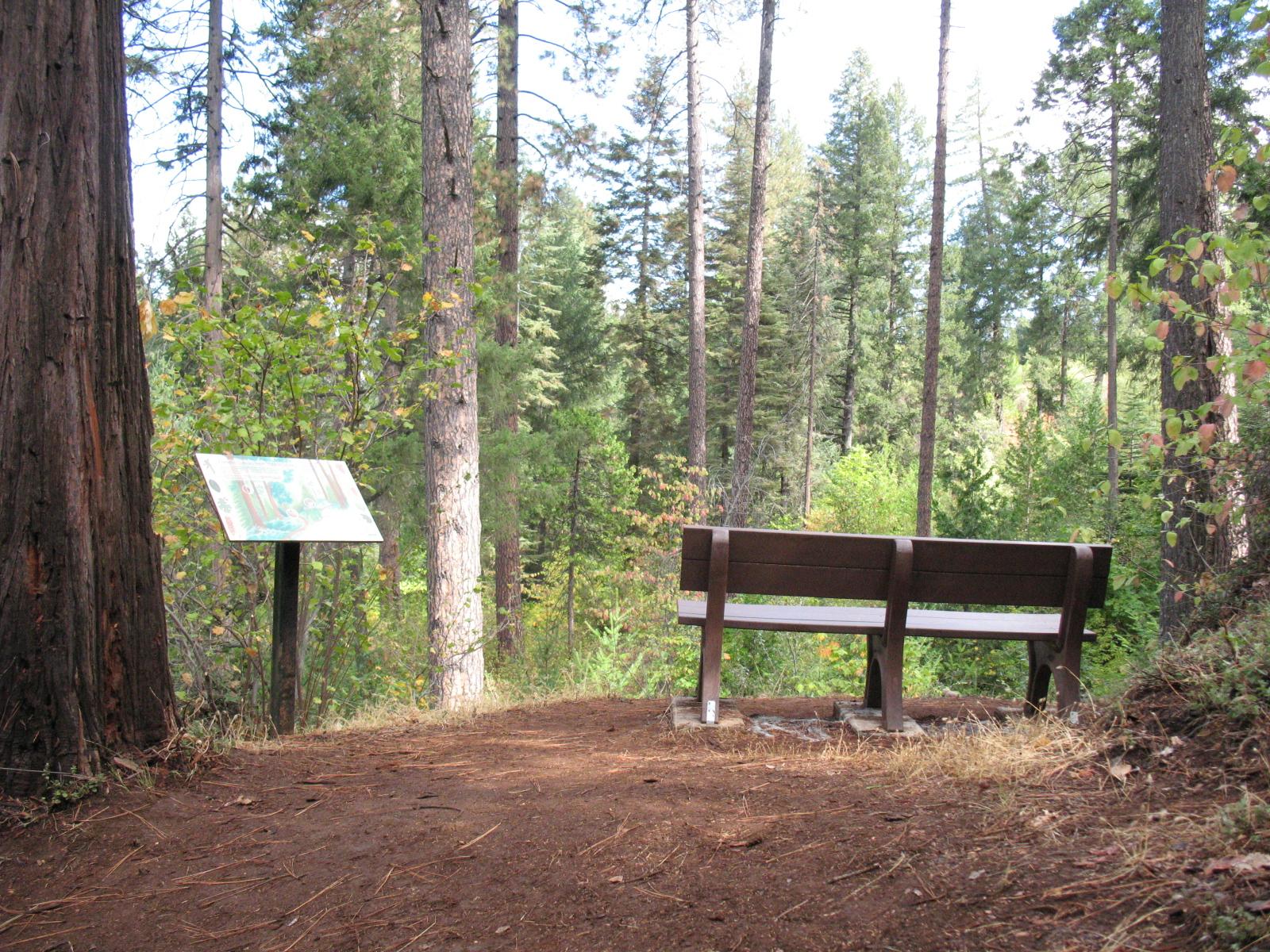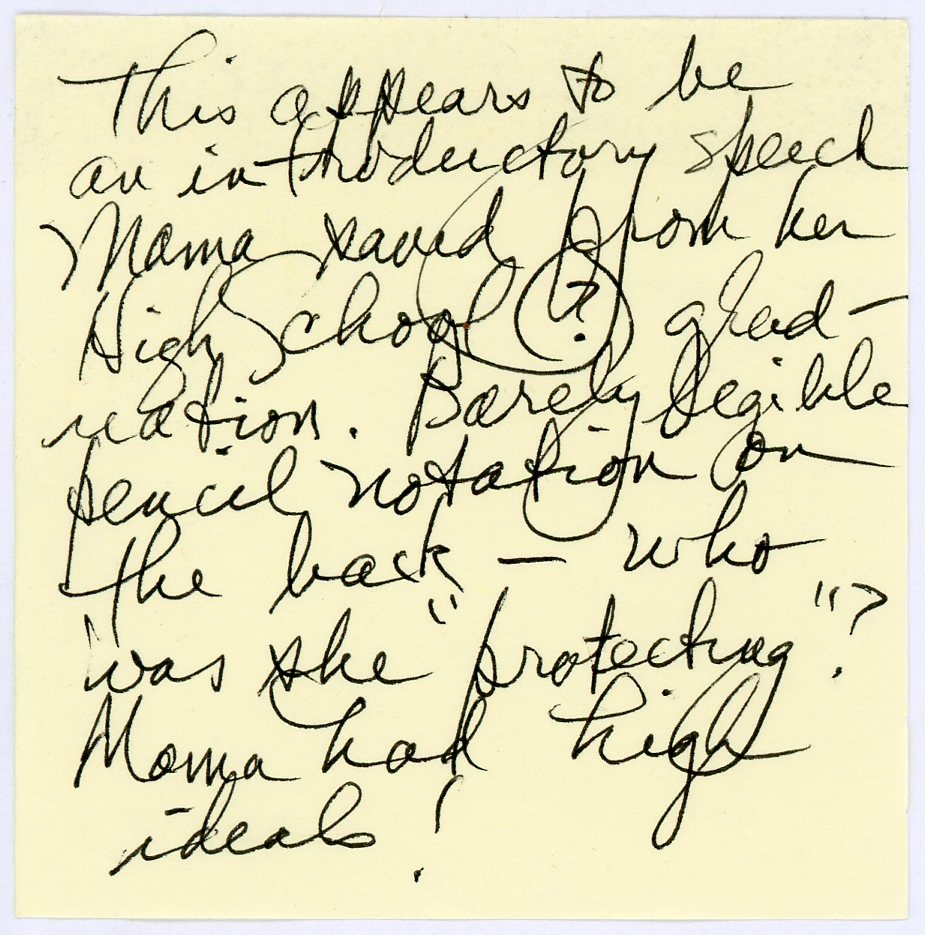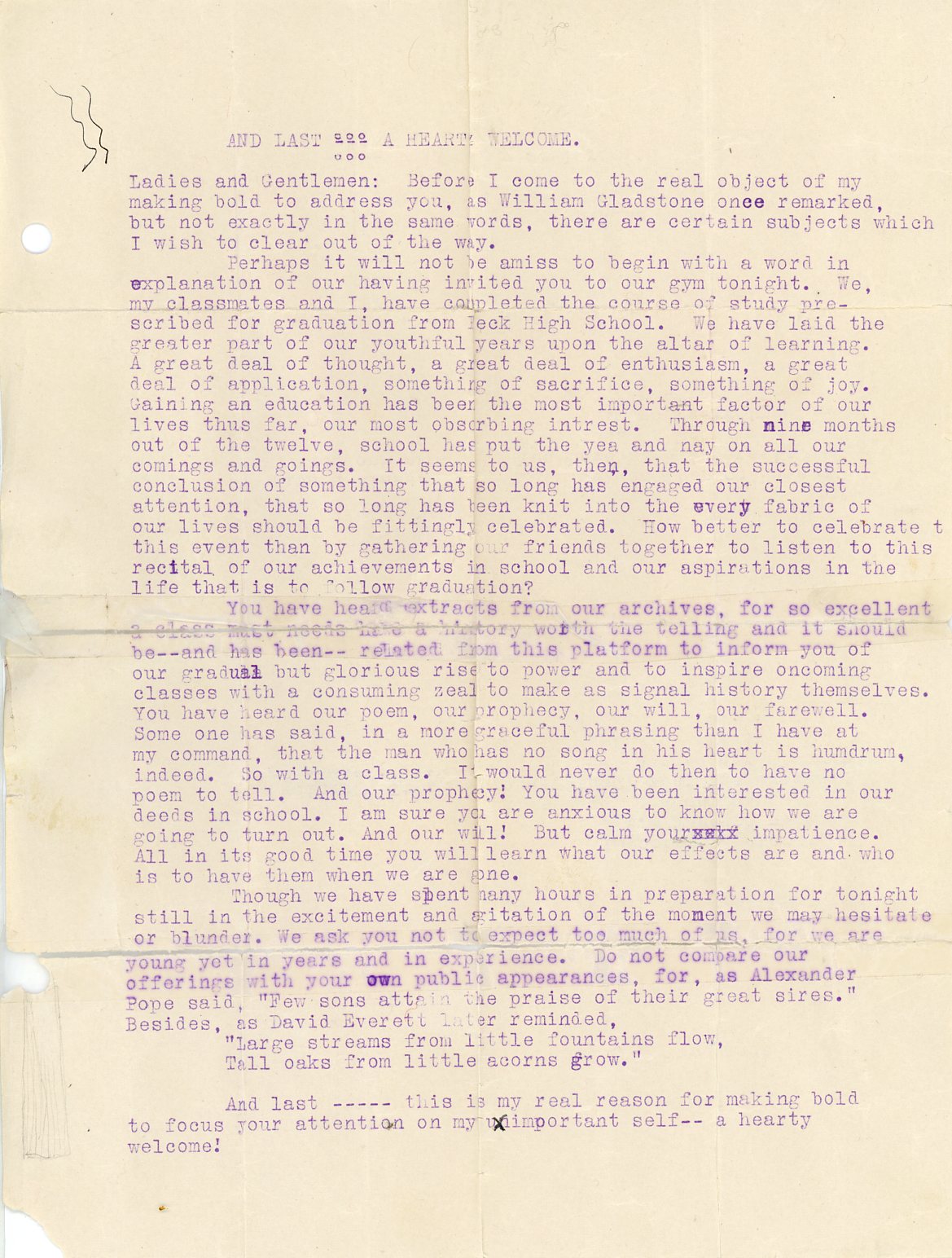Wetherall-HardmanWilliam Bascom Wetherall and Louida Orene Hardman
|
Bill and Orene in censuses
1920 census 1930 census 1940 census Forthcoming. |
||||||||||||||||||||||||||||||||||
Children and other descendantsForthcoming |
| William Wetherall and Orene (Hardman) Wetherall Chronology | ||||||
|
The following chronology spans the life of William B. Wetherall, who lived 102 years, during which he practiced law for over 70 years, and the life of his wife, Orene Hardman, who lived 89 years. It mentions also vital events in the lives of their parents and children, and world events that especially affected their lives. See sections below the chronology -- Progenitors, Beginnings, Childhoods, Schooldays, College, San Francisco, Grass Valley, Endings -- for details, stories, photographs, and other materials related to selected events in their lives. For details about the lives of their ancestors and descendants, see related pages on the Trailhead menu. |
||||||
| 1911-1937 Iowa, Idaho, Nebraska | ||||||
Infancy, childhood, grade school, high schoolWBW -- Ames, St. Maries, Knoxville, Des Moines, UticaLOH -- Central Ridge (Steele), Peck
College and workWBW -- St. Maries, Moscow, Orofino, Pierce -- student, forest service, attorneyLOH -- Peck, Lewiston, Kendrick, Pierce -- student, teacher
|
||||||
| 1937-1942 San Francisco | ||||||
United States Court of Appeals for the Ninth CircuitWBW, LOH -- Marriage, Piedmont, Kirkham, birth of BillyWBW -- Law clerk for Judge HealyLOW -- College, housewife, mother
|
||||||
| 1942 Portland, San Francisco | ||||||
George Black & Company, Auditors and CounsellorsWBW-LOW -- Separated by WBW's work, birth of JerryWBW -- Portland, attorneyLOW -- San Francisco, Kirkham, housewife, mother
|
||||||
| 1942-1947 San Francisco | ||||||
Office of Price Administration (OPA)WBW-LOW -- Kirkham, 24th Avenue, birth of Mary EllenWBW -- OPA enforcement attorneyLOW -- Housewife, mother, volunteerThe Office of Price Administration (OPA) regulated prices and rents during World War II (1939-1945) and for a couple of years after the war, in order to prevent inflation. On 29 May 1940, President Roosevelt established the Council of National Defense Advisory Commission to study the impact of the outbreak of the war in Europe on 1 September 1939. The commission included a Price Stabilization Division and a Consumer Protection Division to deal with issues like inflation and rent control. On 11 April 1941, these divisions were consolidated as the Office of Price Administration and Civilian Supply (OPACS) within the Office for Emergency Management. By 8 December 1941, when the United States declared war on Japan, Germany, and Italy, the civil supply functions of OPACS had been transferred to the Office of Production Management, leaving just the OPA. Under the Emergency Price Control Act of 30 January 1942, the OPA became an independent agency with the authority to impose ceilings on the prices of all commodities except agricultural products. The OPA was controversial among profit seekers, and there were movements to limit its powers if not close the agency even before the war ended on 2 September 1945. But it was popular among consumers, and each year it was renewed. After the war, however, its popularity declined, and its authorization was allowed to expire in June 1946. Prices and rents immediately jumped, and inflation was so rampant that by late July the agency was partially reactivated for another fiscal year. By the end of 1946, though, most of its operations were transferred to other agencies and most of its offices had closed. The OPA was formally abolished on 29 May 1947 under the General Liquidation Order of 14 March 1947. Unsettled matters were transitioned through the Office of Temporary Controls or directly taken over by other agencies. Effective 1 June 1947, on-going litigation concerning price violations had been transferred to the Department of Justice.
Because of impending liquidation of OPA and the transfer of its remaining functions to other agencies, we are forced to curtail staff. We have ranked employees on the basis of the reduction of forces regulations of the Civil Service Commission and find that we must give you this notice of separation from OPA effective May 31, 1947. |
||||||
| 1947-1955 San Francisco | ||||||
Malone & SullivanWBW-LOW -- 24th Avenue, 33rd AvenueWBW -- Attorney in San Francisco law firmLOW -- Housewife, mother, volunteer
To be continued. |
||||||
| 1955-1957 Grass Valley | ||||||
Berliner & WetherallWBW-LOW -- Grass Valley, Silver WayWBW -- Partner in Nevada City law firmLOW -- Housewife, mother, volunteerGrass Valley and Nevada City
To be continued. |
||||||
| 1957-2013 Grass Valley | ||||||
William B. Wetherall, Attorney at LawWBW-LOW -- Grass Valley, Silver WayWBW -- Private practice in Nevada CityLOW -- Housewife, mother, volunteer
To be continued. |
||||||
ProgenitorsBig Bang No signs of Wetheralls or Hardmans. They probably slept through it. Genesis Present-day Wetherall-Hardman descendants bear some resemblance to early anthropoid primates, but physical anthropologists have given up hope of finding missing links. The Flood Two apes who didn't make the cut sneak aboard the Ark under Noah's nose just as the rising waters lift it off the chock blocks and wash away the gangplanks. Years of practice passing as humans begin to bear forbidden fruit. Columbus A lot of people had been living in the Americas, descendants of people who migrated from other continents long before the Americas came to be known as such among European explorers and adventurers. The geographical roots of most of those in the north go back to ancient migrations across land bridges that once connected present-day Siberia and Alaska. Some of those in the south originated from early Pacific migrations. A few Africans and East Asians also appear to have drifted to the Americas before Norseman, Iberians, and other Europeans stumbled upon its shores. Colonialists After Columbus and others like him, waves of Europeans came, saw, and conquered -- and colonialized and settled in -- what was to them the "New World". There is no evidence that any Wetherall-Hardman ancestors arrived aboard the Mayflower or another renowned ship. But arrive they did, and most likely they didn't swim or fly, or just pop out of the bushes. Conspiracists contend that at least one of the seemingly witless among the ancestors of the Wetherall-Hardman family not unwittingly carried the simian genes of post-diluvium Wetherall or Hardman progenitors to what became North America by stowing away on a pirate ship that wrecked off the coast of Newfoundland. Slaves Chattel slaves, bought and sold and otherwise treated as personal possessions, were brought in substantial numbers to most of the colonies, mainly from Africa. Long before the founding of the United States in 1776, slaves had become an integral part of the plantation economies of most of the colonies that became the original 13 Union states. There is no evidence, yet, of slavers among Wetherall-Hardman ancestors. But in the direct Wetherall ancestral line, the Baldwin-Howard family of Virginia had social and economic relationships with local slave-owning families during the years leading up to the Civil War and the early years of the war (see Slavery in Lee County on Baldwin-Steele page). And William E. Wetherall may have been related to slave-holding Wetherall families in Maryland (see Slaveholding We(a)theral(l)s in Harford County, Maryland). Indians There is no documentary or DNA evidence of nominally "Native Amerian" (indigenous, before-Columbus) blood in the Wetherall-Hardman family. And to the best of my knowledge, stories of Native American ancestors in close collateral lines are refutable for lack of objective evidence. However, my mother and her closest relatives grew up in families that had homesteaded on the Nez Perce Reservation in Idaho after it was opened to settlers in 1895. Her parents and relatives, and she herself, had economic and social relationships with Nez Perce people during the early 20th century when survivors of the Nez Perce War of 1876 were still alive. And my maternal grandmother, Ullie Hardman, was active in historical society activities with Nez Perce representatives at the time of Idaho's centennial in 1963. See the Hardman-Gallaher, Hunter-Thomas, and Hardman-Hunter family pages. See also the Nez Perce page, and Cherokee blood on the Baldwin-Steele page. The origins of the many ancestors of William Bascom Wetherall (WBW) and Louida Orene Hardman (LOH) of the "Wetherall-Hardman" family remain obscure. The names Wetherall and Hardman have English and German roots, but they represent only two of the myriad families that form just one of the myriad pyramids of families that link all humankind. The top 4 generations alone of the Wetherall-Hardman pyramid involves 15 families resulting from unions between 16 lines.
Every generation back doubles the number of families on whose shoulders later generations stand. |
Beginnings1911-03-23 Ida Mae (Baldwin) Wetherall -- expecting her first child any day -- sends a postcard from Ames, Iowa to her oldest sister, Sadie (Baldwin) Williams, who is working at a hospital -- probably the local insane asylum -- in Medical Lake, Washington.
1911-03-25 "William Bascum Wetherall is born in Ames, Iowa, the first son and only child of William Riley Wetherall (1890-1936) and Ida Mae (Baldwin) Wetherall (1890-1923). His father may have printed his birth announcement cards. Ames Bill told this writer (his son WOW) in April 2010 that he thought he might actually have been born in Des Moines but a number of documents suggest otherwise. Correspondence from his mother to her sister two days before his birth was postmarked "Ames, Iowa". His birth certificate, birth announcement card, and his children's birth certificates also state "Ames, Iowa".
Ames In 2010, Bill had in his possession several copies of the above birth announcement card and envolope. Curiously, the face of one of the envelopes, though unstamped, was addressed in Ida's hand to "Mr. and Mrs. N. B. Baldwin / St Maries / Idaho / Box #52". Bascum Bill's birth certificate, like his birth announcement card, states that his middle name was "Bascum" and not "Bascom" -- which crept into use later in life. He was unable to explain when or how the change in spelling came about. His "Bascum" namesake was his maternal grandfather, N. B. Baldwin, aka as N. Bascum Baldwin, or just B. Baldwin, but more fully Newton Bascum Baldwin. In 2010, Bill gave N. B. Baldwin's first name as "Nathanial" rather than Newton. 1911 When Bill is 6 months old, his parents move from Ames to St. Maries, Idaho, where Ida's parents at least one of her older sisters are living. All three sisters would play a part in his upbringing, and Sadie and her children, who were about his age, would remain his closest relative from the Baldwin family.
1911 Fall Sometime during the fall of 1911 Bill's mother is admitted to an asylum for the insane in Clarinda, Iowa (testimony in an interview on 8 March 2011 recorded at his Grass Valley home by Gregg Schiffner). 1911-1912 When Bill was around 8 months, his father took him to St. Maries to live with his maternal grandparents, and his mother was transferred to an asylum at Orofino, Idaho. She would remain there until her death in 1923. Bill said in 2010 that his father took them to St. Maries when he was about 6 months old and that she was committed to the Orofino Asylum when he was about 8 months old. The recollection of detail like "Clarinda" in 2011 makes it the more likely place where she was first hospitalized. Bill said, in a story he told his family for the first time around 2000, that his mother was committed to an asylum in Orofino not long after he was born. In 2010, he said his parents had moved to St. Maries from Ames when he was 6 months old, probably because of her mental condition, and that she was commited when he was about 8 months old, at the end of 1911 or the beginning of 1912. However, the 1914-15 public directory for St. Maries shows Wetherall William R (Ida M), printer St Maries Gazette, St Maries, while the 1916-1917 directory shows Wetherell [sic = Wetherall] William R (Ida M), printer St Maries Gazette, St Maries. These directory entries imply Ida M. was William R.'s wife, and suggest that either she was living with him then, or he was socially posturing as though she was living there. North Idaho Asylum What Bill called the "Orofino Asylum" appears to have been the popular name of what was more formally the North Idaho Asylum. The asylum was built in 1905 on the outskirts of Orofino because the state's asylum at Blackfoot was full. John W. Givens North Idaho Asylum was set up and operated by Dr. John W. Givens, who had previously worked at an asylum in Oregon and at the Blackfoot asylum in Idaho. Givens was Idaho's 73rd licensed doctor and its 1st licensed "alienest" -- as psychiatrists were then called. He ran the Orofino institution for 20 years, which included the entire period that Bill's mother was a patient there. He was born in 1854 in Placerville, California, where his parents had migrated from Illinois during the earliest years of the Gold Rush, though he would be raised in Oregon. Placerville Bill would settle in Grass Valley north of Placerville in the heart of California's Mother Lode. Eleanor Theodasia "Theo" (Thomas) Vincent, Orene's slightly younger 1st cousin once removed (her mother's 1st cousin) and her closest relative outside her immediate family, would live with her husband, Hubert Wilton Vincent (1916-2002), in the Mother Lode towns of Auburn and Placerville. And Clara Yang, Bill and Orene's "adopted" daughter, would settle in Placerville and practice law in an office called Motherlode Law -- a name conceived for her by this writer. Orofino is a 1895 reincarnation of Oro Fino ("fine gold"), a small gold mining camp built in 1861. The town was established on parts of the Nez Perce Reservation that were opened for homesteading in 1895, and remains a very small town today -- about 3,000 people. Orofino and Peck Orofino is situated along Orofino Creek at its confluence with the Clearwater river about 10 miles upstream from Peck -- a truly tiny hamlet (about 200 people) just off the river on Big Canyon Road. Orofino and Bill Bill's first job as an attorney, after being admitted to the Idaho Bar in 1937, was as an assistant to the public prosecutor in Orofino. Peck and Orene Peck was the birthplace in 1913, and later the home, of Orene Hardman, Bill's future wife, who spent the earlier years of her life on a homestead farm on Central Ridge, which is reached from Peck by a steep, rocky, and windy grade. Peck, in Nez Perce County, is about 30 miles upstream from Lewiston, the county seat, oppostie Clarkston in Washingon. at the confluence of the Clearwater and Snake rivers. Orofino is the county seat of Clearwater County. Central Ridge, including Central Ridge Cemetery, where a number of Orene's paternal and maternal ancestors are buried, was originally in Nez Perce County, but since 1915 it has been in Lewis County, the county seat of which is Nezperce. Place names The place names come into sharper relief when illuminated by the darker history of the consequences of the Lewis and Clark Expedition of May 1804 to September 1806 on the Nez Perce people. Captain Meriwether Lewis and Second Lieutenant William Clark -- the first Americans of European-descent to trek across the newly acquired Louisiana Purchase (1803) and beyond the continental divide to the northwest coast of the Pacific Ocean -- cut right through the areas where they and the Nez Perce people would be memorialized in numerous local placenames. The explorers were inevitably followed by waves of settlers, who drove the Nez Perce off their original lands, all but destroyed their nation under the leadership of Chief Joseph in the Nez Perce Wars of the 1870s, then proceeded to homestead most of their reservation land. 1912 The earliest surviving pictures of Bill after he was brought to St. Maries, Idaho are the following three snapshots taken on a cold but sunny day on the boardwalk along buildings fronting what is presumed to be the main street of St. Maries. The time of year would have been the winter of early 1912, shortly after Bill arrived at his new home, before he is able to walk.
To be continued. PHOTO GALLERY 1913-11-21 Louida Orene ("Bug") Hardman is born in Peck, Idaho, the second daughter of Owen Monroe Hardman (1890-1949) and Ullie May Hunter (1891-1980).
1914-1915 Orene makes her debut as a professional model.
|
|||||||||||||||||||||||||||||||||
Childhoods1914-05-21 Bill's paternal great-grandfather, William Edwin Wetherall (1834-1914), dies at age 79 in Knoxville, at the home of his son, Bill's paternal grandfather, William Franklin Wetherall. WEW's walking stick William E. Wetherall once served in the Iowa state legislature as a representive of Marion County. Among the few mementos of his Iowa family that Bill in his possession in 2010 was a walking stick with the initals WEW carved on the knob. When and how he received what he called a "cane" -- whether from his father or from an Iowa relative -- remains a mystery -- as does its whereabouts now. It was a true heirloom, which Bill had kept in the closet of his Grass Valley home, among his clothes and shoes and ties and other such things that would have thrown out when he empited the house in 2012 in preparation for its sale. "It's just a stick" he (or someone helping him) might have thought at the time. 1915 When Bill is 4 years old, his father, still living in St. Maries, takes him to Knoxville, Iowa to visit his paternal grandparents, William Franklin Wetherall (1858-1929) and Laura Belle (Beaman) Wetherall (b1866, dc1941). 1915-03-25 Bill celebrates his 4th birthday with a party hosted at the Baldwin home in St. Maries, Idaho.
To be continued. PHOTO GALLERY |
||||
Schooldays1917-06-05 Bill's father, WRW, registers for the first draft in St. Maries during World War I. 1917 Summer When Bill is 6 years old, his father takes him to Knoxville and leaves him in care of WFW and Laura Wetherall, his parents and Bill's grandparents, while working as a printer at The Carroll Times in Carroll, Iowa. Bill would live with his Knoxville grandparents for the next 7 years, and complete his education through the 8th grade in Knoxville in 1924. 1917-09-06 The Pella Chronicle, published in a town near Knoxville and serving the same Marion county readership, reports that WRW had returned to Knoxville from Carroll, as he had been "called to the colors" and would be leaving for St. Maries, where the article said he had "enlisted" on 5 June. However, Bill said in 2010 that his father had been drafted. And WRW's registration card clearly shows that he was hoping for an exemption on grounds of having a 6-year-old son who was dependent on him for support. He stated on the card that he was married but did not list his wife as a dependant. 1917-10-12 to 1919-03-18 William R. Wetherall serves a 17-month stint in the U.S Army. WRW served in France but arrived in the war zone in time to witness the start of the armistice in November 1918. According to a headstone application made to the War Department by Nellie in 1938, following his death in 1936, WRW had been a Corporal in Battery "D" of 336 Field Artillery, which was the heavy artillery component of the 162d Field Artillery Brigade of the 87th Infantry Division of the National Army. 1919-03-22 Bill's maternal grandfather Nathanial Bascum Baldwin dies in St. Maries, Idaho. He is buried in Woodlawn Cemetery in St Maries. 1910s-1920s Orene wore her hair long and curled until she was around 10 years old. Around 1920 the family took her to Lewiston to have her tonsils removed. The January 1920 censuses for St. Maries, Orofino, and Central Ridge in Idaho, and for Knoxville and Des Moines in Iowa, reveal the whereabouts and statuses of Bill, Orene, and their parents.
1920 The January 1920 censuses for St. Maries, Orofino, and Central Ridge in Idaho, and for Knoxville and Des Moines in Iowa, reveal the whereabouts and statuses of Bill, Orene, and their parents.
1921 Bill's father, William Riley Wetherall, marries Nellie (Van Houton). Whether and when William R. divorced Ida Mae is unclear. 1920 censuses (see above) show him to be married, her to be single, and Nellie to be single. William R. is a "printer" working at a "shop" and Nellie is a "file clerk" working for a "magazine publisher". Their daughter, Mary Arleen (Wetherall) (Van Ryswyk) Wells, born in 1922, said in 2013 that they had met at the People's Popular Monthly in Des Moines, where he was a typesetter and she was a proofreader. The 1930 census shows them to have been 39 and 31 as of April 1930, but gives 31 and 22 at their ages at first marriage. William B. Wetherall reported only that his father had divorced his mother but was unable to say when. 2 April 1923 Bill's mother, Ida Mae (Baldwin) Wetherall, dies in Orofino, Idaho. Ida Mae's death certificate states that she was born in 1888. The cause of death was "Arteriosclerosis" (one year) and a contributory cause was "Insanity" (five years). The certificate gives "St. Maries, Idaho" as her "Former or usual residence" and "St. Maries, Ida" as the "Place of burial or removal". In 2010, Bill said he didn't know the particulars of his mother's death and took the position that it didn't matter. As an attorney who did considerable work in probate and inheritance matters, he was totally familiar with the procedures for obtaining copies of vital records, and could easily have done so. He was simply not motivated to know more. Woodlawn Cemetery Ida was Buried as "Ida Baldwin Wetherall" in the Baldwin plot at Woodlawn Cemetery in St. Maries, Idaho. Bill resided and at times worked in St. Maries between 1928 and 1937. Whether he visited his mother's grave at the Baldwin plot is unclear. The provenance of the color photograph he had of the plot, which clearly showed his mother's grave, is also unclear. Memories of mother Bill said in 2000, and repeated in 2010, that he had only two memories of his mother. One was of seeing her sitting on a swing on the grounds of the asylum. Another was of himself walking ahead of her and Grandma Baldwin on the board walk between the asylum and the town of Orofino. He remembers hearing his mother call "Wait, Willie, I want to walk with you." He told this story at the table after dinner one night in Grass Valley a year or so before Orene's death. He broke down in tears such as we had never seen before. 1924 Bill completes grade school through the 8th grade in Knoxville. Skips grades Bill said in 2010 that he had skipped the second half of kindergarten into 1st grade, then skipped part of another grade. By the time he was in the 3rd grade, he had skipped a total of about a year, but because he was a year behind when he started, he was about par for his age, perhaps a little ahead, because he thought he had actually skipped around two grades. Born in March 1911, he would have turned 13 a couple of months before his graduation in the spring of 1924, which would make him among the younger graduates of his class. He seemed to be doing the math in his head while talking. 1924-1928 Bill works on Uncle Charley's farm in Nebraska for 5 summers (6 summers if from 1923), the first following the 8th (7th) grade in Knoxville, the last following his senior year in high school in Des Moines. Uncle Charley Uncle Charley was Charley Anstine, the husband of his Aunt Lydie, Ida Mae's second older sister Lydia. The farm was in Utica, Nebraska, a few miles from Seward, where the Anstines lived, in the eastern part of the state close to Iowa. According to Bill's account in his interview with Gregg Schiffner on 8 March 2011, the first summer Uncle Charley came to Knoxville to pick him up, and camped out at the fairgrounds overnight -- "That's what people did in those days." From the next summer Bill went to Nebraska by himself. His uncle always gave him a little money when he went home, and the last three summers he was paid a full 30 dollars a month plus found -- the standard wage for a hired farm hand. 1924-1928 Bill attends East High School in Des Moines and graduates circa 6 June 1928. Life in Des Moines During his high school years, Bill lived with his father's new family in Des Moines, where his father was working for People's Popular Monthly. 1925 census The 1925 Iowa state census shows Wm. R. Wetherall, 36, his wife Nellie, 26, a daughter Mary A., 2, and a son Wm. Wetherall, 13, living at 1308 E 25 Court in Des Moines, in a home valued $2,500 with $2,100 mortgage. The datumm for the census was 1 January, so Warren, who was born on 2 January, isn't listed. To be coninued. PHOTO GALLERY OF PIX OF ORENE WETHERALL 1925 The Wetheralls are almost outed during the Scopes Monkey Trial in Tennessee. Young Bill, reading about the trial in The Des Moines Register, and beginning to dream of becoming a lawyer, writes Clarence Darrow a letter offering himself as living evidence that Darwin was not wrong. Darrow puts Bill on the stand, but no one believes his explanation of the origin of the bananas on the Wetherall family crest, and Scopes is found guilty as charged of violating a Tennessee law proscribing the teaching of human evolution in a state-funded school. No one today believes this story, either. 1928 Bill wins first place in East High's Lincoln Essay Contest for an essay titled "Our Debt to Lincoln". He receives a large bronze Lincoln medal, which later he would used in his office as a paperweight. The essay was published in the March 1928 issue of The Quill (page 5). A report headlined "Lincoln Esssay [sic] Medal Awarded to William Wetherall" noted that "The Lincoln-Washington Assembly was held on Wednesday, February 22. The Lincoln Essay medal was awarded to William Wetherall, who is Editor-in-Chief of the Quill. His theme was "Our Dept to Lincoln." It also named a number of students who gave speeches, one titled "Crown Our Washington", or related anecdotes about Lincoln. One student gave "A Toast to the Flag" and another sang "Land of Mine" and "on the Sea". All in all, the assembly exemplified the efficiency of patriotic education in the days when American heroes were untarnished by rumors of their human failings. The Quill was East High's quarterly literary journal. The March 1928 issue of the journal (Volume XXIV, No. 3) states that it was "Published four times a year by the students of East High School, Thirteenth and Maple Sts., Des Moines, Iowa." It was not a cheap mimeograph knockoff, but was printed on glossy paper that accommodated black-and-white photographs and bound in a proper cover. And it was not cheap. "Subscription price, $1.00 a year." William Wetherall had become a member of its editorial staff, and by then had become the Editor-in-Chief. |
|||||||||||||||||||
College1928 Summer Bill works on Uncle Charley's farm after graduation from high school. Bill said in the 8 March 2011 interview that the farm was 360 acres -- "half a section" he added, a section being 640 acres. He said that Charley offered him "a quarter" of the farm or "produce" -- apparently meaning a quarter of the income from the farm, since Charley didn't own the land -- if he would join him on the farm. However, he told his uncle he planned to go to college. 1928 Penn College After finishing his summer work (or when school was out?) Bill moves into an apartment with a high school friend who had gotten a job maintaining an apartment building for his room rent at Penn College, a Quaker school in Oskaloosa, Iowa (later William Penn College, now William Penn University). Oskaloosa is about 25 miles east of Knoxville.
I worked a week or two, cleaning floors and so on. Just as he was about to enroll in Penn College, Bill decides to go west -- "follow the advice of Horace Greely" in his words. Grandma Baldwin was still alive in St. Maries. His Aunt Meda, the yougest of his mother's three older sisters, born two years before her, also lived in St. Maries, where she had married Clifford Ure, a postman, as Bill remarked without hesitation in 2010 when telling this writer about his St. Maries family. His aunt Sadie Williams also still lived in the larger Spokane, Coeur d'Alene, and St. Maries area of eastern Washington and western Idaho, as did Sadie's children, his slightly older cousins Faye and Claude Williams. All would continue to be Bill's closest relatives. 1929 Bill enrolls in the University of Idaho after its proctor visited St. Maries to recruit students and offered Bill a job cleaning his home. 1930 Bill receives a fresh-off-the-press copy of Roget's Thesaurus from his step-mother Nellie in Des Moines. Enclosed was a note in which Nellie said she knew Bill didn't need it because he already knew all the "nyms" but it might come in handy anyway. The envelop was addressed "William B. Wetherall" and dated "1930" but the note began "Bill" and was signed just "Mom". He would treasure it the rest of his life and give it to his good friend Gregg Schiffner of Nevada City with other favorite books. c1930s Orene completes two-year normal school program at University of Idaho and begins teaching at Yellow Rose School, Little Bear Ridge, between Kendrick and Troy in Latah County, Idaho, where she was residing in 1935 (according to 1940 census). 1935 Bill graduates from the University of Idaho in Moscow, Idaho, where he met Orene Hardman (1913-2003), his wife to be, and the mother to be of his three children. 1935-1937 Bill attends and graduates from College of Law, University of Idaho. 1935-1936 Summers Bill works in blister rust control out of Civilian Conservation Corps (CCC) camps in Montana. Blister rust refers to a fungal disease that damages or kills several varieties of western white (five-needle) pines. The fungus, called Cronartium ribicola, spreads from tree to tree through an intermediate host, mainly currants and gooseberries, or "ribes". Eradication programs involved removal of ribes from around stands of pines, and cutting away infected parts of trees before the fungus could girdle and kill them. The work amounted to a mixture of brush removal and logging. The Civilian Conservation Corps (CCC) was created in 1933 as a public work program for unemployed unmarried men of families on relief during the Great Depression. The men, aged 18-25, received food, clothing, and shelter, plus 30 dollars a month, 25 dollars of which they had to send to their families. One of the ten general work categories in the program was "Forest protection: fire prevention, fire pre-suppression, firefighting, insect and disease control". William Wetherall was 25 in 1936. This writer recalls him saying that he sent the money to his Aunt Sadie in St. Maries, who put it aside for his college expenses. 1936-07-04 Bill's father, William Riley Wetherall (born 2 May 1890), dies on Independence Day at age 46. Bill was working in blister rust control in Montana, out of a camp that was 25 miles from the nearest town, when he heard of his father's death. He didn't go to the funeral, because he didn't have enough money and couldn't afford to miss work, and said he never visited his father's grave. He assumed the grave was in Knoxville but said the family didn't have a family plot. However, a Works Progress Administration (WPA) Graves Registration Survey conducted in the late 1930s records that a William R. Wetherall (1890-1936) was buried at Graceland Cemetery in Knoxville, Marion County, Iowa, and that he had served in the World War. W.R. Wetherall's father, William E. Wetherall (1835-1914), is also buried at Graceland Cemetery. This writer has no recollection of visiting the cemetery when the Wetheralls visited Knoxville in 1957. Bill's father was survived by Bill's step-mother, Nellie (Van Houton) Wetherall, who his father had married around 1920 or 1921, and four half-siblings -- Mary (13), Warren (11), Helen (8), and Marjorie (2). Nellie would continue to raise the four children in Knoxville. She remarried in 1943 and was widowed again in 1945, by which time Mary had married and had a son, Warren was serving as a Private First Class in Germany, and Helen and Marge were still living with her at their Knoxville home. 1937-08-16 Bill is admitted to the Idaho State Bar on or about 16 August 1937. Bill received a letter from the Clerk's Office of the Supreme Court of the State of Idaho, postmarked and dated 6 August, to the effect that the court had that day ordered his "admission to the practice of law in the State of Idaho upon the payment of the required fees and taking the oath" -- which was scheduled for 16 August at the Supreme Court in Boise. According to clippings of newspaper reports in Knoxville, Iowa, initated by his paternal grandmother Laura Wetherall, he was among the 4 who passed the exam out of 12 who took it. The envelope containing the notification was addressed to "Mr. William Bascom Wetherall, / ST. MARIES, IDAHO." It was forwarded from St. Maries to "Orofino, Idaho. / c/o Samuel F. Swayne" on 9 August. Swayne was the Prosecuting Attorney of Clearwater County in Orofino, and Bill had been clerking for him.
1937 Bill's first job as a licensed attorney seems to have been as a clerk to Sam Swayne, then the prosecuting attorney of Clearwater County in Orofino, Idaho. It is not clear the prosecuting attorney's position was full time. Nor is it clear that Bill was officially the "deputy" prosecuting attorney. His own testimony suggests that he was looking forward to being Swayne's junior partner in private practice. In any event, his sojourn in Orofino was very short.
Samuel Swayne's nationality problemBy the time this story broke, my father had accepted an appointment as a clerk for William Healy (1881–1962), a federal judge at the United States Court of Appeals for the Ninth Circuit in San Francisco. My mother followed my father to San Francisco in 1938 and they married, thus beginning the California era of their lives, and sealing the fate of their three children, all born in San Francisco, and raised first there and then in Grass Valley, California. If my father was aware of Swayne's nationality issue, he did not mention it to me, even though he was aware of my interest in the subject. I ran across the article to the right when trying to gather information about Swayne for this history. It delighted me, because nationality issues rank high among my interests. Swayne's case exemplified the way most nationality laws in the world worked at the time, and the way many nationality laws still operate today. More importantly, though, it dramatized the manner in which educated adults -- even people who are supposed to be familiar with law -- may be unaware of their own nationality, presuming they have a nationality which in fact they don't possess (such as Swayne in Orofino in 1938), or assuming they have lost a nationality which in fact they still hold (such as Renho, a Parliamentarian in Japan in 2016). As of August 1936, Swayne was the assistant prosecuting attorney at Orofino. I assume he was elected the prosecuting attorney by the time my father was working as his assistant a year later. |
|||||||||
Love letters1935-1952 Correspondence from my mother to my father, which began during their courtship about the time she began teaching at Yellow Rose School. Nearly 100 of the letters, which span 1935 to 1952, are dated 1935-1937, and many of them touch upon adventures at Yellow Rose School. Here I will introduce a few of the letters that reveal Orene's life at the school, under the title "The confessions of a country school marm" (as she described herself). Some of the situations are hilarious. One her pupils was Mary Thomas, a younger 2nd cousin. Eight decades later, I would share family history data with Niki Thomas, the wife of Mary's son Tom Thomas, who is thus my 3rd cousin. Some of incidents at the school were minor scandals that involved conflicts with students, parents, and even the superintendent's office. The confessions of a country school marmForthcoming. |
San Francisco1937 Fall Bill is appointed law clerk to Judge William Healy (1881–1962) of the United States Circuit Court of Appeals for the Ninth District in San Francisco. The US Circuit Court of Appeals for the 9th District was established in 1891 with a complement of 2 judges. The number of authorized judges grew to 3, 4, and then in 1935 to 5. Judge Healy was added in 1937 when the complement was increased to 7. Its original jurisdiction was California, Oregon, Washington, Idaho, Montana, and Nevada. The territories of Hawaii and Alaska were added in 1900, and Arizona when it became a state in 1912. The judicial district of Guam was formally added in 1951, after Bill had left the court for private practice. Judge Healy, born and educated in Iowa, had been practicing law in Boise, Idaho in the early 1930s. As this writer understands the story, Bill, on the recommendation of the dean of the law school, had done some clerking for Healy while a law student, and the dean informed of the opportunity to serve as Healy's clerk when Healy was appointed to the federal court judgeship in San Francisco in 1937. The judge and his young clerk undoubtedly had a lot of stories to swap about both Iowa and Idaho. 1938-06-01 Bill and Orene are married at the Trinity [Episcopal] Church in San Francisco. 1939 Bill is admitted to the California Bar 1941-03-23 Bill and Orene's first son, William Owen Wetherall, born at St. Mary's Hospital in San Francisco. The family was living at 5 Piedmont Street in the Ashbury Heights neighborhood of San Francisco at time, and was living there when Pearl Harbor was attacked on 7 December 1947. 1942 Bill works for George Black and Company, a Portland accounting firm, for about 6 months during the middle months of the year. 1942-09-11 Bill and Orene's second son, Jerry Alan Wetherall, born at St. Mary's Hospital in San Francisco. The family was living at 2244 Kirkham Street in the Sunset District at the time. Bill was still in Portland at the time of Jerry's birth. 1942-10 Bill begins working for the Office of Price Administration (OPA) as a West Coast Regional Litigation Attorney. While working for the OPA, a federal agency within the Office for Emergency Management, he learned that OPA had mediated with the local draft board to exempt him from military service on the grounds that contribution to OPA's wartime price control mission was vital to the economic war on the domestic front. He continued to work for OPA until its abolishment in 1947. During this period, Wetherall had an opportunity to work and travel with Cecil F. Poole (1914-1997), who after his discharge from military service in 1946 moved to San Francisco and took a job as an OPA research attorney. During their travels by train, which required overnight stays, Wetherall witnessed how they were treated at hotels which refused Cecil a room because he was black. This aspect of America -- land of the free, home of the brave -- was new to Wetherall, but not Poole, who had grown up with Jim Crowism, and witnessed it during his military service in segregated units. Poole soon became an assistant district attorney in San Francisco, and would later become a U.S. attorney and then a federal judge at the Ninth Circuit U.S. District Court in San Francisco. 1945-01-24 Bill and Orene's daughter, Mary Ellen Wetherall, born at St. Mary's Hospital in San Francisco. The family was living at 1922 24th Avenue in the Sunset District at the time. Their wish for a daughter this time came true. 1947 Bill joins Malone and Sullivan, a San Francisco law firm in the Mills Tower building in downtown San Francisco. The senior partners were William M. Malone and Raymond L. Sullivan. Other attorneys in the firm included Contrad T. Hubner and William J. Dowling, Jr. William M. Malone (1900–1981), born and educated in San Francisco, was the senior partner in the Malone and Sullivan law firm at Suite 1005 Mills Building, 220 Montgomery Street, which broke up when Sullivan left the firm in 1961 to become a judge. Malone was also an influential local, state, and national Democratic Party leader during the Roosevelt and Truman years, and spent more time as a political boss than as a personal-injury litigator. He participated in the Democratic National Convention in 1940 (Chicago), 1944 (Chicago), 1948 (Philadelphia), 1956 (Chicago), and 1960 (Los Angeles), at which John F. Kennedy became the party nominee for the presidential election. His absense from the 1952 convention (Chicago) came at a time when he resigned his leadership posts in the thick of a scandal that that implicated his own brother and other political (mostly San Francisco Irish) associates, some of them Truman appointees to federal posts, in alleged misdeeds. Their accuser was the congressional Kefauver Committee, led by Tennessee representative Estes Kefauver, who was investigating organized crime. Kefauver would become the Democratic Party's nominee for Adlai Stevenson's running mate in both the 1952 and 1956 presidental elections. Malone's partner, Sullivan, was also a staunch Democrat, and undoubtedly the partners took William B. Wetherall's Democratic pedigree into account when hiring him in 1947. Raymond L. Sullivan (1907-1999) became an Associate Justice of the Court of Appeal, First Appellate District, Division One (1961-1964), the Presiding Justice of the Court of Appeal, First Appellate District, Division One (1964–1966), and an Associate Justice of the Supreme Court of the State of California (1966–1977). His appointment to the California Supreme Court in 1966 was Democratic governor Pat Brown's last (and, for political reasons, somewhat secretive) judicial appointment. After retiring from the bench, Sullivan taught at Hastings College of Law in San Francisco, his birth place and the home of the Malone and Sullivan law firm since the 1930s. William J. Dowling, Jr., a graduate (like Malone and Sullivan) of the University of San Francisco Law School, left Malone and Sullivan in 1956 for Cooper, White & Cooper, another San Francisco law firm. The Dowlings were Sunset District neighbors and remained friends of the Wetherall family after its move to Grass Valley in 1955. Two Dowling children would settle in Nevada City, Brian Dowling as a middle school teacher, and Sean Dowling as an attorney who would later become a State of California Superior Court, Nevada County judge. 1949 The family moves to 1558 33rd Avenue in the Sunset district, and the children attend nearby Lawton Elementary School. Until then, Billy and Jerry had been commuting to Notre Dame des Victoires, a French Catholic school in downtown San Francisco, though the family was neither French nor Catholic. They attended NDV because the woman in the bed next to Orene's, in the maternity ward at St. Mary's Hospital, who gave birth to a daughter a couple of days before Billy was born, turned out to live in the same neighborhood on 22nd Avenue, and she was Catholic. It made sense for their children, who grew up as cradlemates and playmates, would go to school together. |
Grass Valley1955 Bill moves moves the family from San Francisco to Grass Valley in order to join Nevada City attorney Harold Berliner in a partnership -- "Law Offices, Berliner & Wetherall, 232 Broad Street, Nevada City". Bill saw the move as an opportunity to leave the city he loved for the rural life he loved more. Until then, he always took his family camping during the summers. After the move to Grass Valley, family summer vacations ended. 1958 In the summer of 1958, for the first time since his marriage to Orene, Bill visits Iowa, driving his family there from Grass Valley. The five members of the Wetherall family stayed with Bill's paternal Aunt Alice and her husband, Wilbert "Bill" Dainty" and their three children, Willard "Will" Duane Dainty (1933-2010), Thayne Dainty (b1940), and David Shiree Dainty (1942-1996). Alice was his father's youngest sister, and she helped raise him when he was living with his grandparents in Knoxville in the late 1910s and early 1920s. Bill met for the first time in perhaps thirty years two of his three half-sisters: Mary Arleen Wells of Carlisle, Iowa, and Helen Ann Morrison (c1928-2002) of Waterloo, Iowa. A half-brother, Warren H. Wetherall (1925-1999), a third half-sister, Marge Thomas, and their mother Nellie, Bill's stepmother, lived in Banning, California. Warren's daughter, Kathleen Anne Wetherall, may still live in California. 1959-1979 Bill serves as City Attorney for Nevada City, a part-time position. During his tenure, he oversaw the drafting of local historical preservation ordinances -- including Ordiance 338, adopted by the City Countil in 1968 and known as the "Nevada City Historical Ordinance" -- which defined "the Mother Lode type of archiecture" that characterizes Nevada City's "Historical District". Nevada City's ordinances became models for other foothill communities. 1962 The shingle of the 232 Broad Street law offices of Berliner & Wetherall becomes just William B. Wetherall, Attorney at Law. Bill later moved to the 222 Church Street office (J. F. Siegfried building) immediately across from the Nevada County Courthouse. The sign canterlievering from the building by the entrance read "Wm. B. Wetherall / Attorney at Law". A small sign on the door said "Law Offices". Beyond the front door was a hall with first a door to the secretary's office (which had several chairs for clients), then a door to his office (used as an exit from his office), then a broom closet, and finally a toilet. He would stay in this office until 2000. Harold Berliner (1923-2010), who had become Nevada County's District Attorney in 1957, left the partnership to assume full-time duties and engage in other activities. During his service as District Attorney, which continued until 1973, Berliner would co-author the famous "Miranda warning" or "Miranda rights" (1968). As the DA and as a private citizen, he would make significant contributions to the improvement of not only county land-use laws, but also to environmental and consumer protection statewide. 1962-1974 Bill serves as a director of the Nevada County Fair Board. 1975-12-03 Bill has the first of two hernia operations he would have in his lifetime. 1983-1988 Bill serves as a director of Music in the Mountains during its formative years. 1985-04-27 Bill receives a letter from the Director of the Selective Service System. "As a result of a computer check of government files, you have been identified as someone who should be registering with Selective Service. Men born on or after January 1, 1960, must register within 30 days of their 18th birthday. Because of a similarity in names we sometimes send letters like this to men who have already registered. To assist us in correcting our records, please complete the enclosed form as follows." 1994-10 At 11 o'clock in the evening of Saturday, 15 October 1994 Bill agrees to go to the emergency room at Sierra Nevada Memorial Hospital to find out what was causing a very severe stomach pain with a tender and distended abdomen. Within a few days he would undergo abdominal surgery to remove a cancerous section of his sygmoid colon and direct the descending colon to an ostomy. The staples were removed on Monday, 24 October, and both he and Orene began learning how to live with a colostomy. In a few months he began to feel pain again, but this time it was attributed to attachments. Six months later, half a year ahead of schedule, he underwent a second abdominal operation to reconnect his plumbing, and he would never show signs of metastatis. 1997-01-18 Bill receives the 1996 Elza Kilroy Award from Nevada City Chamber of Commerce for efforts to make Nevada City a better community. The aware recognized in particular his service from 1959 to 1979 as city attorney, during which time the city's historical ordinance was adopted by the city council. 1998-06-24 Black bear sighted on Gold Hill Drive near Wetherall home -- one of many bears sighted Grass Valley and Nevada City that spring and summer. 1998-10-19 Bill receives the Maestro Award from Music in the Mountains in recognition of his support since its formative years. 2000-09 Bill receives a Certificate of Appreciation from Judges of the Nevada County Superior Court for his years of service to the legal community, including his years as Nevada City Attorney. The award was made after he had announced his tentative retirement, though, he would continue to practice law in the city for another two or three years. "I thought we got rid of this guy!" 2000 Bill closes his Church Street office immediately across from the Nevada County Courthouse, but continues practicing law, which by then consisted almost entirely in writing trusts, from the back room of his home in Grass Valley -- "the boys' room" which Billy and Jerry had shared with relatively little territorial feuding and a bunk bed. (His obituary, based on other sources, reported 2003, but he had moved his office to his home around the year 2000.) 2001-04-22 Surprise buffet held for Bill at Christopher's Catering on Colfax Avenue in Grass Valley in celebration of his "first ninety years", which he had reached on 25 March. The party was organized by Mary Ellen and Orene and cards were printed by Judith Berliner. The party was attended by all three Wetherall children and most other family members and some relatives, and by many neighbors and friends. Bill was lured out of the house by an invitation to another event. Orene, a co-conspirator in the surprise for Bill, was the object of another surprise. Standing with Bill in the reception line, she nearly had a heart attack when she spotted Saori and Tsuyoshi walking through the entrance. Clara and Ben had picked them up at the Sacramento International Airport the day before. She later said she thought something was going on, but Bill appeared to have been totally surprised. |
Endings2003-06-01 Bill and Orene celebrate their 65th wedding anniversary. 2003-07 Orene, who had osteoporosis, and whose general condition had notably weakened in recent years, suffers a stress fracture in her spine when attempting to rise from a chair in the living room. After a couple of weeks in the hospital -- weary of the treatment, and aware that she was experiencing the sort of slippage she had witnessed in her own mother and others she had nursed after they had suffered geriatric fractures -- Orene resolved to go home and face a more dignified ending. A few days later, as she began to eat less and sleep more, at her request, arrangements were made for Hospice care. 2003-08-09 Orene dies at age 89 in the presence of Bill, and their son Jerry and daughter-in-law Purita, who had come from Honolulu the day before. Mary Ellen, who lived a few minutes away, came shortly later. Billy, in Japan, arrived four days later. 2003-08-21 A simple secular memorial service is held at Hooper and Weaver Morturary in Nevada City. Close neighbors and many local friends, and a couple of relatives from other localities, attend.
2007-03-25 On his 96th birthday, Bill writes a sonnet titled "Ode to Orene" -- "In every rose I see her radiant face". 2007-11 Bill completes the third and "final" draft of "The Parable of the Little Feather", a short story about an encounter with an oracle while hiking in the woods. 2009-10-20 Bill completes a draft of "The Struggle to Save Ott's Assay Office". The 23-page single-spaced report begins "Ott's Assay Office and the South Yuba Canal Building in downtown Nevada City, California, are widely revered as historical and architectural icons of the epochal mining era in the West." The report ends with the declaration that Nevada City is now "world-class mecca . . . beautifully cradled in the foothills of the Sierra Nevada, in the "other Eden" -- not of England, as Shakespeare would have it, but Nevada County, California." 2009-11-05 Bill is profiled in an article in The Union as "Weathering it all: Attorney still practicing law at 98". 2010 Bill collapses in late Autumn from a minor stroke, which all but ended his driving and practice of law at the age of 99. Bill had to stop driving his car but continued driving himself. He finished a couple of trusts he had been working on but accepted no new work -- except on his own behalf. His last act as an attorney at law was to draft the third and final ammendent to his own revocable trust, which he signed in January 2013. In the ammendent, he resigned as the acting trustee, and appointed his second son and adopted daughter as co-trustees. He reserved his power to revoke the trust but consigned all his financial affairs to his co-trustees, essentially declaring himself incompetent. 2011-03-25 Bill celebrates his 100th birthday with family, friends, neighbors, and colleagues at a party held on 27 March at the Miners Foundry in Nevada City. 2013-06-19 Bill dies in Nevada City, in the city he loved, at the home of his caregivers -- close to Orene, whose ashes were in his room -- close in minutes, miles, or spirit to his children and their families -- close to his local friends and neighbors -- and close to the Orene Wetherall Trail. William B. Wetherall's favorite poem began with this line.
Orene Wetherall Trail and Orene Wetherall and William B. Wetherall memorial bench The plaque on the memorial bench has the following inscription.
|
|
Orene's treasuresMy mother left several boxes of personal belongings consisting of things she kept from her childhood and youth, as well as photographs and other detritus related to her Hardman-Hunter family. Of the five large plastic boxes and two file drawers that constitute the Wetherall Family Collection, about 3/4ths comes from her side of the family. Other than the photographs, most of which are identified or identifiable, the most important personal effects are her diary, autograph book, and an very interesting hardcover scrapbook-cum-album full of clippings and photographs and jottings from her highschool days. Orene's treasures also include two items which qualify as heirlooms -- Matilda, a porcleain doll that has been handed down from her mother's family -- and a Nez Perce bag she received from a woman she befriended on the occasion of the 1932 Cherry Blossom Fesival. |
Orene's autographs (1927-1930)Orene Hardman's autograph book includes 47 leaves plus one back free fly paper. The front free fly paper appears to be pasted down to the front end paper, and what would have the 48th leaf appears to have been torn out. All but two entry's in the autograph book are dated 1927 and 1928. Orene and Burton Hunter (1914-1973), her slightly younger maternal uncle, who was raised as her brother from age 5, graduated together with Peck High School Class of 1931. Orene made an entry on the back end paper of autograph book. Burton made an entry on . . . TO BE CONTINUED.
0. 1927-05-25 Norla Callison [maternal 1st cousin] (Front free fly pasted down)
1. 1927-01-27 Delina W. -- Peck
2. 1928-03-09 Donald Black
3. 1927-06-03 Osie
4. 1928-08-07 Viola -- Peck [maternal aunt]
5. 1927-06-04 Jennie Hardman [paternal step-grandmother]
6. 1929-01-02 Mrs. Dan Lyle -- Peck
7. 1927-11-23 Homes "Fred" -- P.H.S.
8. Blank
9. 1927-06-24 Jewell Choate
10. Harry D. Earls -- Peck
11. 1927-06-22 Maxine Keene [1st cousin]
12. Bieby (?)
13. 1927-06-24 Nedra E. Swain
14. 1928-11-28 Louise Choate "29" -- Peck
15. 1927-06-24 Audna Powell
16. 1928-10-29 Walter Lacey -- P.H.S.
17. 1927-06-24 Aubra Horne -- Peck
18. 1928-07-06 Your "Skinny" Aunt -- Kendrick [Eva, maternal aunt]
19. 1927-06-02 Ina (Peck)
20. Loren B. (Peck)
21. 1927-10-12 Roy Ray Luffman -- Peck
[Born Orofino 1910, Peck 1920, Camus 1930, died Orofino 1990]
22. Blank
23. Gorden Fairly (29)
24. 1928-10-23 Dick
25. Emmett Leeper ('27)
26. 1928-08-07 Almeda (Peck) [maternal aunt]
27. 1927-10-13 Josephine Gordon
28. 1928-11-28 George Devlins ("Senior")
29.-30. 1927-11-23 Edna Moe (?) = E.M.B.
31. 1927-11-09 James Gillespie -- Peck
32. Blank
33. 1927 M?? (?) [appears to be 2 or 3 initials]
34. Blank
35. 10-11 Beth -- P.H.S. ("28")
36. 1928-02-09 Mabel Murray -- Orofino (OHS '29)
[Born Idaho 1911, Teakean 1920, Teakean 1930, Cavendish 1935,
Orofino 1940, died Orofino 2007, buried Lenore]
37. 1927-02-02 Mary Chapman alias "Midget" -- Orofino (O.H.S. '28)
38. 1928-12-02 Dan Lyle -- Peck
39. 1927-10-13 Lucille Roberts -- Peck (classmate)
40. "Curly"
41. 1927-11-15 Albert Black
42. 1928-07-06 V.B.H.
43. 1927-10-11 Elaine Hersey [SPK gang member "Lee"]
44. 1928-07-06 Elma J.
45. 1927-07-25 Mildred Coon -- Peck
46. 1928-01-02 Bill Lyle -- Peck
47. 1928-10-13 Ralph Everett Gilberstrom (?) -- Peck
48. Blank
49. Burton Hunter [maternal uncle, brother, classmate]
50. 1928-12-31 Edna -- Peck
51. 1927-10-12 Donald C. Holmes -- Peck ('27 classmate)
52. William Coon
53. 1927 John Lyle -- Peck
54. John Tweedy
55. Arol Powell -- Peck ('27)
56. 1928-11 Raymond Luper -- Peck
57. Ralph Lacey -- Peck
58. Blank
59. Edward Knowlton (?) -- Peck ('27 classmate)
60. Blank
61. Bertle L. Melcum (P.H.S. 27-28)
62. 1928-05-26 Lester -- Peck
63. 1927-10-11 Millard -- Peck (A fresh guy of '27)
64. Blank
65. 1927-12-05 R. Thomas Berry -- Peck ('27)
66. Babe Hardman [sister]
67. 1927-11-15 Robert Lay -- Peck
68. 1927-10-26 Donald Smith -- Peck (C.R. School, P.H. School)
69. 1928-02-02 Viola Ogden -- Orofino [1920 Leland, 1930 Gilbert]
70. 1928-11 Arthur Balen (?) (P.H.S.)
71. 1927-12-21 Thomas C. Tumelson (?) -- Peck (P.H.S. "28")
72. 1930-12-14 Dady OMH -- Peck [father Owen Monroe Hardman]
73. 1928-01-30 Mama [mother]
74. 1928-10-25 Ethel Whitman -- Peck (classmate)
75. Norma Smith (P.H.S. 1927-'28, teasing freshie) [SPK gang member]
76. 1932-09-19 Mrs. E. T. Brooks [teacher]
77. 1928-01-27 Ronald Hersey [boyfriend]
78. 1928-12-31 Vern H. Pearson [Minnie France's brother-in-law]
79. 1927-11-17 Ray H. Berry -- Peck (P.H.S.)
80. 1928-08-02 Agnes Jones
81. 1927-12-20 Fred Warren (P.H.S. 28) [boyfriend]
82. 1928-08-01 Opal L. Jones -- Kendrick
83. 1928-01-27 Rowena Parks -- Peck
84. 1929-04-06 Bill GWW (?)
85. 1928-01-15 Irene M. Gurnsey -- Orofino
[formerly Peck neighbor, Born Peck 1912,
Peck 1920, Lewiston 1930, died Oregon 1994]
86. 1927-12-21 Harold Springston -- Peck ('29)
87. 1928-01-27 Ethel S. (?)
88. 1928-07-31 Walt, Ben -- Kendrick
89.-90. 1928-01-27 Opal Gillespie -- Peck [SPK gang member "Pal"]
91. 1927-11-08 M. L. Corum -- Peck [teacher]
92. 1928-07-31 Ernestine -- Kendrick
93. 1927-11-23 Elisabeth Smith -- Peck (P.H.S. classmate 1st year)
94. 1928-11-26 Essie -- Peck ("30") [played together on Central Ridge]
95.-96. Leaf torn out
97. 1927 Wolf R. Johnston [end free fly]
98. Elev T. Brooks [end free fly]
99. Orene Hardman (back end paper)
Mo till brick bats til horse flys until mistakes become hay stacks till Eskimoes wear B.V.D's. til pillow slips until hell freezes over and becomes a skating rink til Brussels Sprouts until the bed springs and the pillow slips until butter flies till Hell freezes over and the devil learns to skate until window panes until Eskimoes wear B.V.D's and Elphants rossts in trees [sic] til the dish rags til the kitchen sinks til the bed springs until Eskimoes wear B.V.D's and Elephants roost in trees until Hell freezes over and the angels come skating home
Memphis Letha CorumThe following entry came from M. L. [Memphis Letha] Corum (1904-1987). She is "Memphis" (6) in the 1910 census for Filer precinct of Twin Falls, Idaho. The 1930 census for Clarkston, in Washington, shows her as "Memphis L."" (26), single, Idaho-born, living with her mother, as a school teacher in a public school. It's not impossible that she was commuting to Peck. The 1940 census for Peck village shows her as Memphis L. (36), single, with 3 years of college education, living with her mother, as a school teacher by occupation and grader by industry. Apprently she never married, and is buried in Vineland Cemetery in Clarktson.
Peck, Idaho. Dear friend Orine, Will write a little poem which reminds of the typical high school student's life. A data, a danaca, Sincerely,
|
||||||||||||||||||||||||
Orene's Peck school book (1929-1933) |
SPK clubForthcoming. Louida Orene Hardman"Orene" 1913-2003 WetherallForthcoming. Opal Marie Gillespie"Pal" 1914-1997 Houston, O'ConnorForthcoming. Elaine Hersey"Elaine" 1913-2006 LairdForthcoming. Minnie A. France"Min" 1912-1995 Ford, LaceyForthcoming. Norma Francis Smith"Norma" 1914-2010Forthcoming. Kathryn Jean Graham"Jean" 1915-2006 HolmesForthcoming. |
Peck High School, 16 May 1931Orene Hardman's high school salutatory addressIn the 8 April 1931 entry of her Diary (see below), Orene Hardman wrote this. Worked on Biology. Had 6 weeks test. Got book from U. of I. [University of Idaho] Was offered "salutatorian" position. Refused. The 13 May entry begins "Started decorating the Hall." The 14 May entry begins "Did some more decorating." The 15 May entry fully reads as follows. Commencement And the 16 May entry follows up like this. All over with! Big crowd. Good program. Hall beautiful. Helped with work to-day. Stayed all nite with Jean [Graham, later Holmes]. Mary Ellen's sticky noteMy sister Mary Ellen, when preparing some of the family documents being stored at her home, for shipment to me in Japan, attached a yellow sticky note to the typed sheet shown to the right. In the note, ME speculated that it might be a speech my mother prepared for her high school graduation. ME drew attention to the penciled note on the back of the speech, which was in my mother's hand. The speech had been twice folded vertically (lateral folds), then twice folded laterally (vertical folds), hence down to 1/16th the size of the unfolded sheet of letter-sized paper -- small enough to fit into a wallet. The note had been written across one of the exposed quarters, which suggests that it was written after the paper was vertically folded, and before it was laterally folded. The speech has to have been written before it was presented on 15 May 1931. But when the note was written, and how much time elapsed between the vertical and lateral folds, is not known. Nor is it known how much time elapsed between the writing of the note and the pencilling out of the name and words. Possibly my mother immediately had second thoughts. But the penciled note appears to have faded more than the penciled marks made to cross out cross out the name and words. So she -- or possibly someone else -- may have crossed them out later. Even using a magnifying glass and varying the light, I am unable to make out the crossed-out name or words -- except the first letter of the words -- "I". Perhaps a forensic document examiner could determine the expunged name and words, and whether the pencil used to cross out them out was the same as the pencil used to write the note.
|
|||||
Orene's schoolgirl diarySee Orene Hardman's schoolgirl diary (1930-1933, 1934, 1937) |
Orene's Sunday schoolForthcoming. |
Orene's boyfriendsRonald Bruce Hersey (1914-1990)Forthcoming. Russell Alonson Betts (1911-1942)Forthcoming. Charles Fredrick "Fred" Warren (1909-1992)Forthcoming. |
Orene's Nez Perce bagsForthcoming. |
Orene's readingOrene was a voracious reader. When growing up, I remember her reading stories in subscription magazines like Saturday Evening Post and Lady's Home Journal. She also read a lot of novels, and later in her life, long after Saturday Evening Post ceased, and she stopped subscribing to women's magainzes, she read mostly fiction borrowed from the Grass Valley library. She didn't buy many books, and only a few of the volumes shelved in our living room, or back room, were hers. But during my many visits from Japan, which averaged 3-4 weeks, she would read a little every day, sometimes in the afternoon, sometimes before going to bed, and finish a couple of books during my stay. For a while she was a member of a local readers club, in which members read the same novel, then talked about it over tea at someone's home. In her high school diary, she mentions and grades several titles. 9 December 1930 23 January 1931 Read "So Big." Good book. 21 March 1931 Read "Behind that Curtain." Good. Apparently the Charlie Chan novel by Earl Derr Biggers first published in 1928 by Bobbs-Merrill Company (Indianapolis) and Grosset & Dunlap (New York). 1 December 1931 5 December 1931 27 January 1932 |
Orene's travelsInterest and action are different. I am a bit of a travel-phobe, a stay-at-home type, a bear that prefers not to wander outside his own niche. I go places only if I have to. Which is not to say I am not interested. I travel vicariously all over the world, around the solar system, throughout the galaxy, to the limits of the universe, and beyond as I wonder how there could possibly be a boundary with nothing on the other side. My parents did not appear to be a good mix when it came to travel. My mother seemed more interested in traveling and I got the impression that she socialized better. By the time my father got around to wanting to travel -- meaning he got the point in his life that he obsessed less about work and was willing to go places and see things -- my mother's health had declined to the point that she didn't want to go anywhere -- especially if he would be driving. My father traveled overseas only twice that I know of -- both times with my mother -- the first to attend my wedding in Japan in 1971, the second to tour Germany, Austria, and Switzerland in 1989. But my mother traveled with her close friend Marguerite Manion and her parents to California, Mexico, and Yellowstone National Park in 1936, and many photographs and postcards from this trip have survived. She also came to Japan by herself in 1979 a few months after the birth of her granddaughter in 1978, and she stayed several weeks. She even took a course in elementary Japanese to prepare for the trip. That my mother travelled more and better does not mean my father wasn't interested in travel. Interest and action are not the same thing. But whatever his interest, other matters -- especially work -- came first -- especially after we moved to Grass Valley in 1955. Before we moved, my father took us on camping vacations every summer. We also went on a number of day trips to picnic. After moving to Grass Valley, though, and became his own boss, he declined to take time off for family vacations. Perhaps he thought that, because we were now living in the country, we didn't need to go camping. Our home was surrounded by woods. There were large ponderosas and cedars in our own backyard. He could have, of course, taken time for family vacations -- scheduled a week or so for a family trip somewhere. Apparently he preferred not to. Travels with Marguerite Manion (1936)Marguerite Ellen Manion (1915-) was born on 4 March 1915 in Blackfoot, in Bingham County, Idaho, to William Edward Manion and Elvira Irene Welsh. She married first Adams, who she later divorced, and then in 1976 married Douglas Lawrence Anderson (b1920). Their marriage license application, filed on 25 February 1976, void after 28 March 1976, in Thurston County, Washington, states that Anderson was 56, a baker, widowed, his 3rd marriage, while Adams (Manion) was 60, a travel agent, divorced, er 2nd marriage. Itinerary
1. Crater Lake -- Oregon
2. General Sherman -- Giant sequoia in Sequoia National Park, Tulare County, California
3. Mt. Shasta -- California
4. Sacramento -- California
5. San Francisco -- California
Fleishhacker Zoo
6. Los Angeles, California
Ferndell (aka Fern Dell), Western Canyon, Griffith Park
A trail toward Griffith Observatory through a woodsy glen
now called Ferndell Natural Museum)
Griffith Observatory -- Los Angeles
7. San Diego, California
San Diego Exposition -- San Diego, California
"San Diego fair" on backs of pictures
"Bugville" picture taken on account of Bug's name
8. Tiajuana -- Mexico
9. Boulder Dam -- Nevada and Arizona border
"Hoover Dam" since 1947
10. Bryce Canyon National Park (National Monument) -- Utah
11. Zion Canyon, Zion National Park -- Utah
12. Yellowstone National Park -- Wyoming, Montana, and Idaho
Japan (1971, 1979)Forthcoming. Europe (1989)Forthcoming. |
Orene's report cardsForthcoming. |
Orene's college papersForthcoming. |
Orene's awards and certificatesForthcoming. |
Orene's petsWhen growing up on the Hardman ranch on Central Ridge in the 1910s and 1920s, the Hardman family pets appear to have been mainly dogs, and at times a coupld of deer. In San Francisco, the Wetherall-Hardman family had at least one canarie and possibly a budgie. The birds didn't last very long, as I recall. We also had a cat, which "fell apart" (as Dennis the Menace famously put it) a couple of times. The cat moved with us to Grass Valley in 1955, and after she died, there were a succession of cats and two dogs. My mother, however, was mostly a cat lover. Within a few of losing a cat, she would find a kitten somewhere. She, not my father, fed the pets, and when she died, though my father had by then been "trained" to put out water and food, the cat my mother left began to wander, apparently finding better food if not more attention elsewhere. The scrapbook Orene Hardman kept while attending Peck HIgh School in 1927-1941 includes a photo of 3 kittens. Another print was found in her collection of unmounted prints. Her preference for cats may have begun after the Hardman-Hunter family moved to Peck from Central Ridge in the late 1920s so that the Hardman girls and their younger uncle, who had been raised with them, could go to high school. To be continued. |
Orene's recipesForthcoming. |
Orene's walletForthcoming. |
Cherry Blossom QueenForthcoming. |
Orene's love ♥ lettersThe confessions of the schoolmarm of Yellow Rose SchoolSee Orene's schoomschoolgirl diary (1930-1933, 1934, 1937). |
Orene Wetherall TrailForthcoming. |
Bill's treasuresForthcoming. |
Babe Ruth's autographForthcoming. |
Lincoln essayForthcoming. |
College papersForthcoming. |
Awards and certificatesForthcoming. |
Indian head penniesForthcoming. |
Classical music recordsForthcoming. |
Heritage Press limited editionsForthcoming. |
Art glassForthcoming. |
River rocksForthcoming. |
William B. Wetherall's law careerLaw school and people he worked withWilliam B. Wetherall (1911-2013) practiced law for about 75 years from 1937 to shortly before his death in 2013 at age 102. His last client was himself when dictating the last amendments to his trust to Clara Yang, his adopted daughter, who he appointed the executor of the William B. and L. Orene Wetherall Family Trust. Clara, his de facto protege, now specializes in estate planning, wills, trusts, special needs trusts, probates, conservatorships, and related matters. |
Law schoolForthcoming. |
Samuel SwayneForthcoming. |
William HealyWilliam B. Wetherall clerked for William Healy (1881-1962) when Healy was serving as a United States Circuit Judge at the United States Court of Appeals for the Ninth Circuit in San Francisco. Healy served as as a judge of the Ninth Circuit Court from 21 June 1937 to 30 November 1958, as as senior judge from 30 November 1958 to his death on 15 March 1962. My father served as Healy's 1st clerk from about 16 September 1937 to 1 September 1932 (but on payroll through 9 October 1942 on account of annual leave taken as salary after physically leaving). Healy was born and educated in Iowa, where he graduated from the University of Iowa Law School in 1908. from 1909 to 1913, he privately practiced in Silver City, then the seat of Owyhee County, Idaho, from 1911-1912. He served as the county prosecutor 1911 to 1912. From 1913 to 1914 he was a member of the Idaho house of representatives, and from 1914 to 1934 he privately practiced in Boise. From 1934 to 1937 he served as general counsel to the Farm Credit Administration in Spokane, Washington. And on 8 June 1937, President Franklin D. Roosevelt appointed him to a seat on the Ninth Circuit Court in San Francisco. William Healy was a friend of the dean of law school at the University of Idaho, who was acquainted with my father's achievements as a law student, and recommended my father. Like Healy, my father was born in Iowa. Though raised until 6 in Idaho, he was educated through high school in Iowa, before returning to Idaho for college and law school. In a letter dated 2 December 1941, describing his career to that point, WBW wrote as follows. I am a member of the Idaho bar, and since coming to California with Judge Healy, I have passed the California bar examination and am now qualified to practice in this state. To be continued. |
Harvey N. BlackForthcoming. |
Cecil F. PooleWilliam B. Wetherall worked with Cecil Francis Poole (1913-1997) as attorneys with the San Francisco Regional Office of the Office of Price Administration (OPA). WBW began began working as an enforcement attorney for the OPA on 1 December 1942 (see the Office of Price Administration section of the Chronology above). On 28 July 1946, he was transferred and reassigned from the Food to the Litigation unit. Poole, who had served in the Army from 24 July 1942 to 24 December 1945, joined the San Francisco Regional Office of OPA in 1946 and served as Chief of its Regional Appellate Division until OPA operations ended in 1947. WBW worked in the same office, under Poole, and on a number of occasions he accompanied Poole on stayover trips to deal with litigation in localities within the catchment of the San Francisco office. When the office closed in 1947, they went their separate ways -- WBW with Malone & Sullivan, Cecil Poole in private practice until his appointment as Assistant District Attorney for the City and County of San Francisco. But they kept in touch, and the Poole family -- Cecil and his wife, and 2 daughters -- once visited our home in Grass Valley after my father left San Francisco in 1955 to work with Harold Berliner and then for himself. Cecil Poole later became a federal judge at the United States Court of Appeals for the Ninth Circuit, where WBW had once clerked for William Healy. Poole then became the U.S. Attorney for the Northern District of California, among other prominent posts. To be continued. |
Malone & SullivanIn 1947, William B. Wetherall joined the San Francisco law firm of Malone & Sullivan, officed in the Mills Tower building in downtown San Francisco. The senior partners were William M. Malone and Raymond L. Sullivan. Other attorneys in the firm included Contrad T. Hubner and William J. Dowling, Jr. To be continued. William M. MaloneForthcoming. Raymond L. SullivanForthcoming. |
Bill DowlingWhile working at Malone & Sullivan, William B. Wetherall became close friends with William J. Dowling. And after my father left the firm and moved to Grass Valley in 1955, the two men kept in touch, and Dowling and his family visited our home in Grass Valley. Two of Dowling's 6 sons later moved to Nevada County. One of them, Sean P. Dowling, practiced law in Nevada City, and he served as a Superior Court Judge in Nevada County from August 2005 until his retirement in January 2015. Sean was present at my father's 100th birthday party in Nevada City in 2011. When announcing his retirement, he made the following remarks, according to a report in the 18 January 2014 edition of The Union, a Nevada County newspaper published in Grass Valley, the largest town in the county near Nevada City, the county seat. I've been blessed with so many wonderful personal and professional relationships that have helped me along, starting with attorney Bill Wetherall, who referred cases to me as a rookie lawyer in 1975. I've had the privilege of being mentored by and working with a host of exceptional judges and staff. To be continued. |
Harold BerlinerForthcoming. |
Clara YangForthcoming. |
